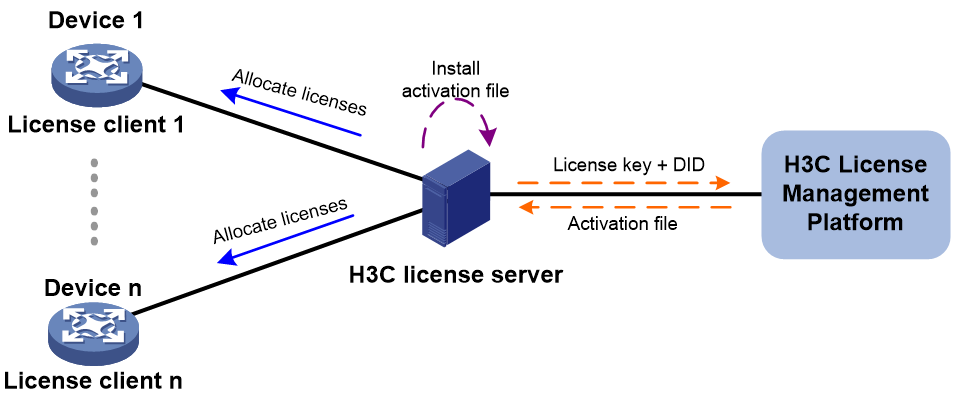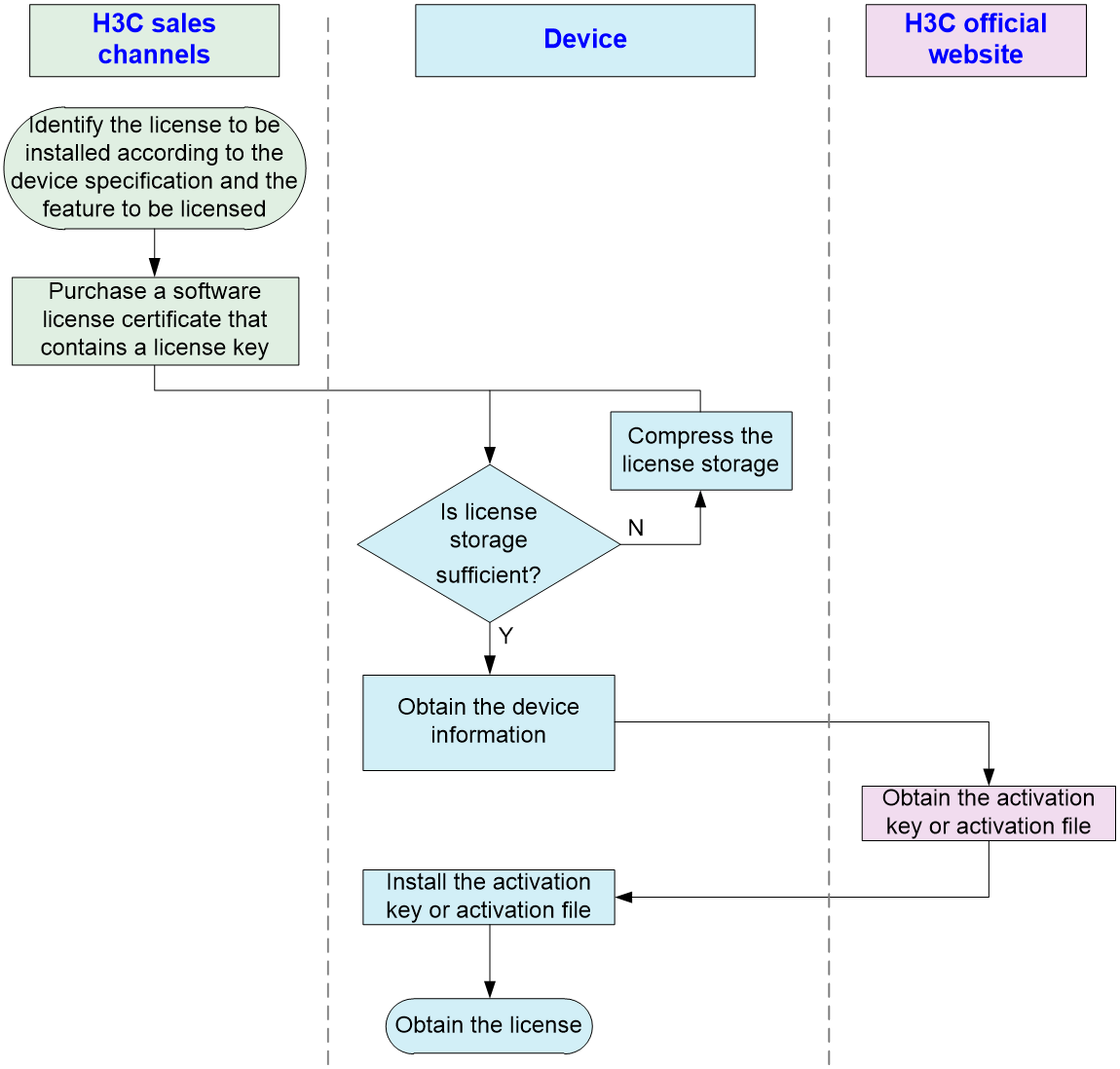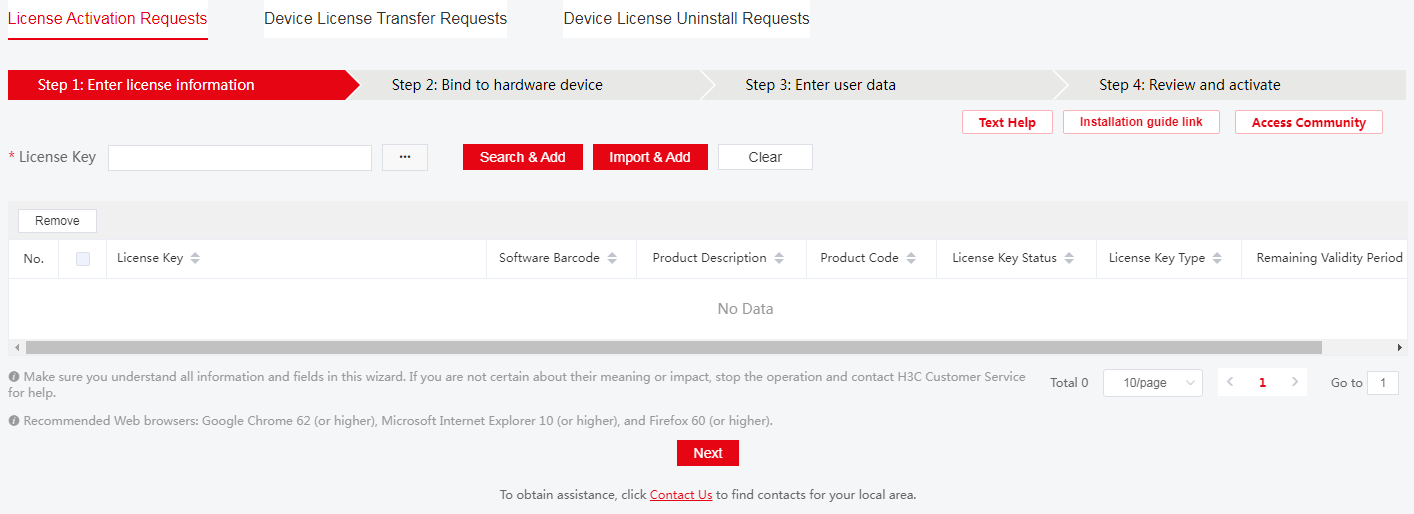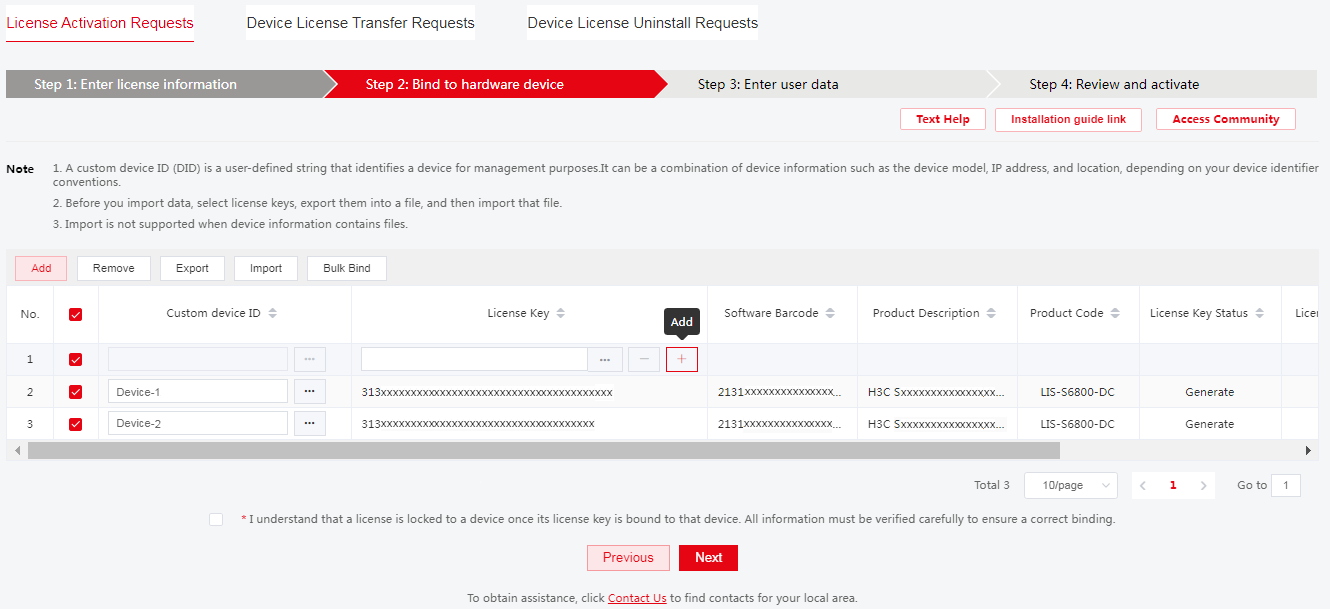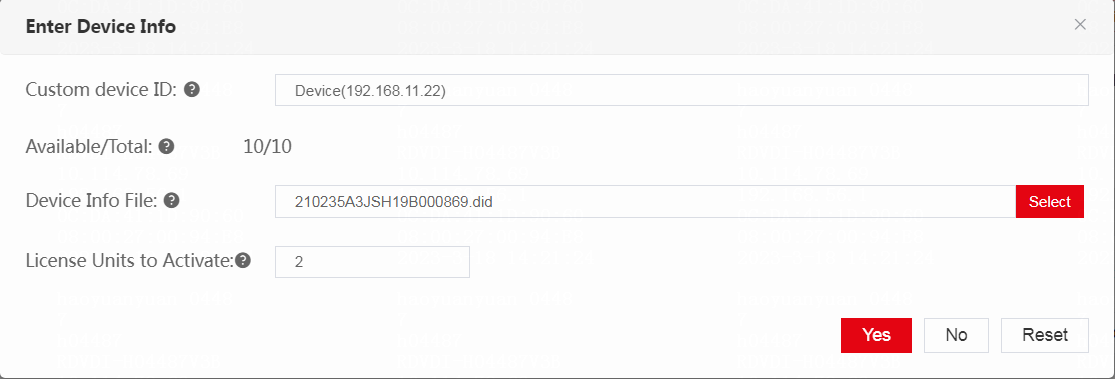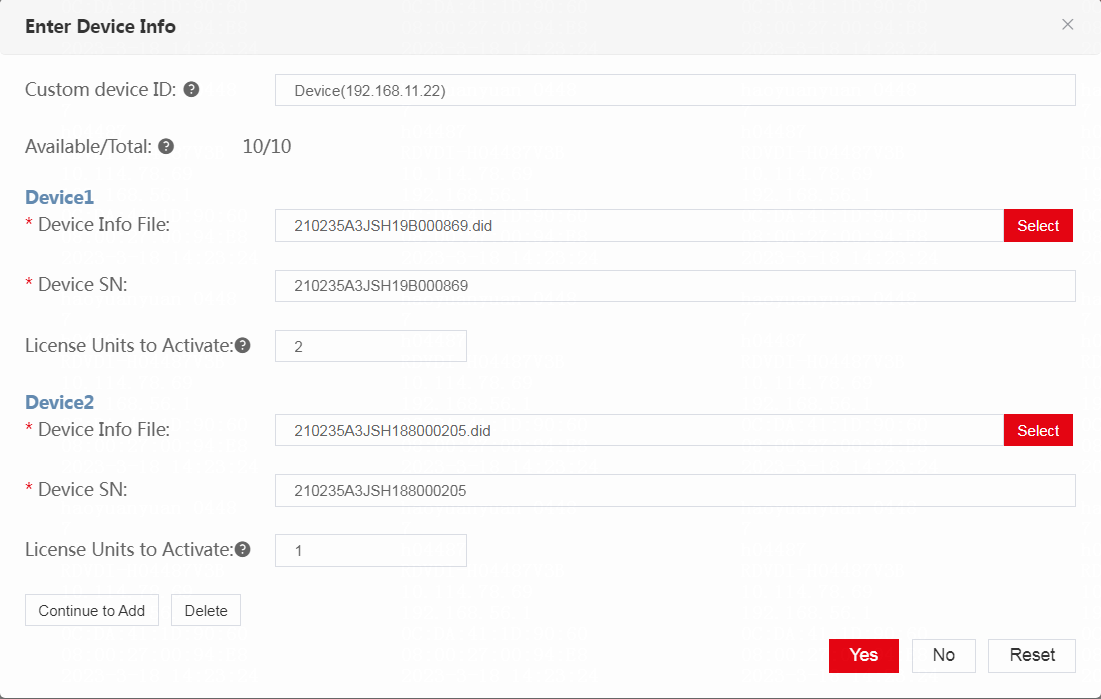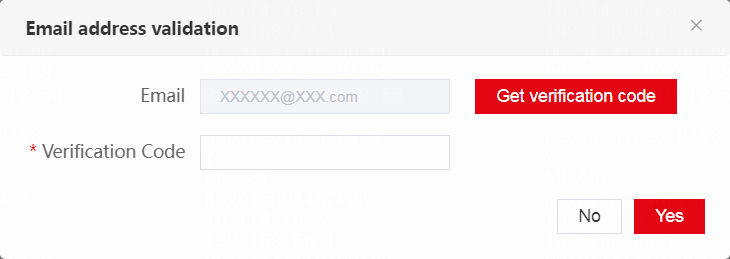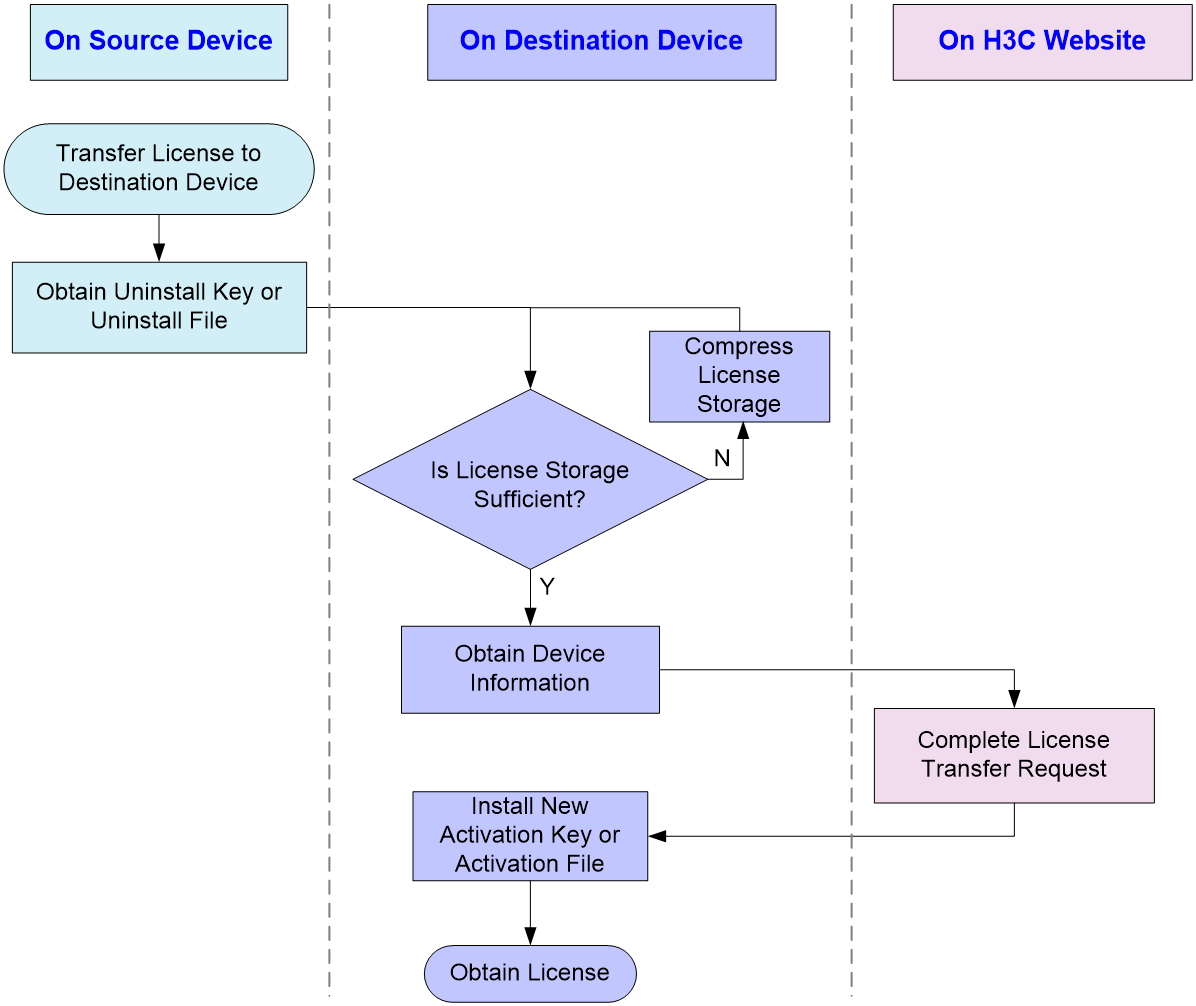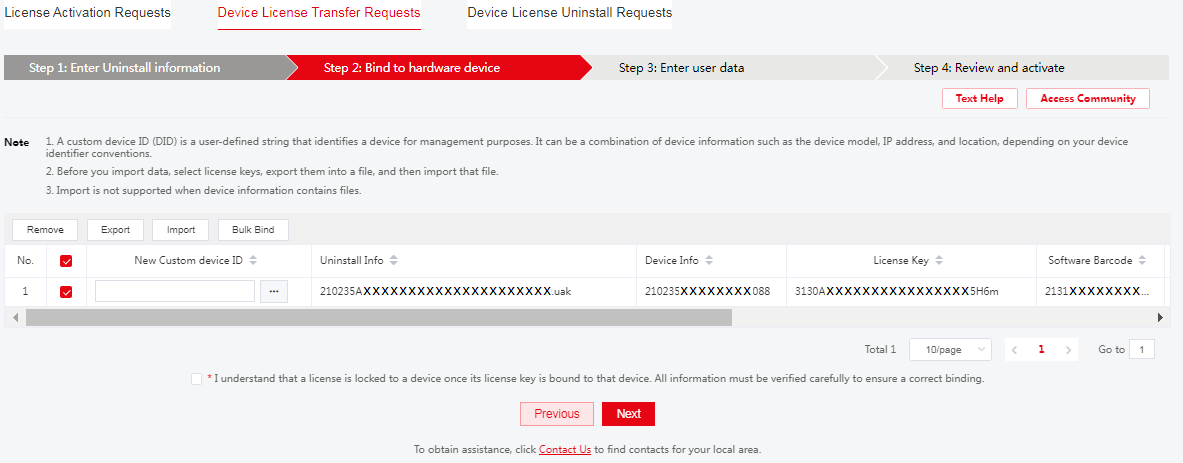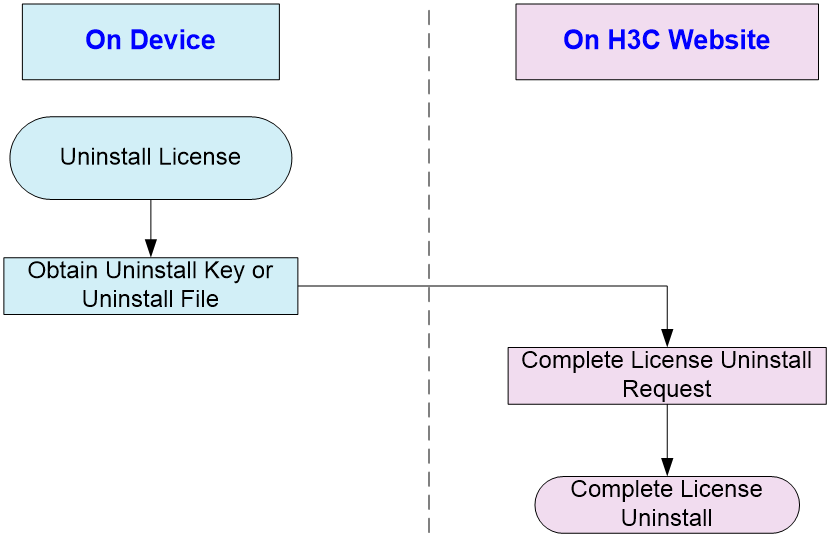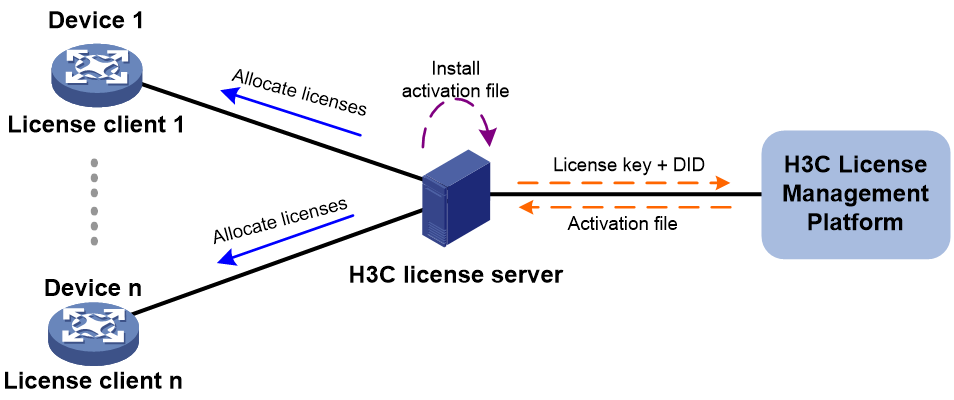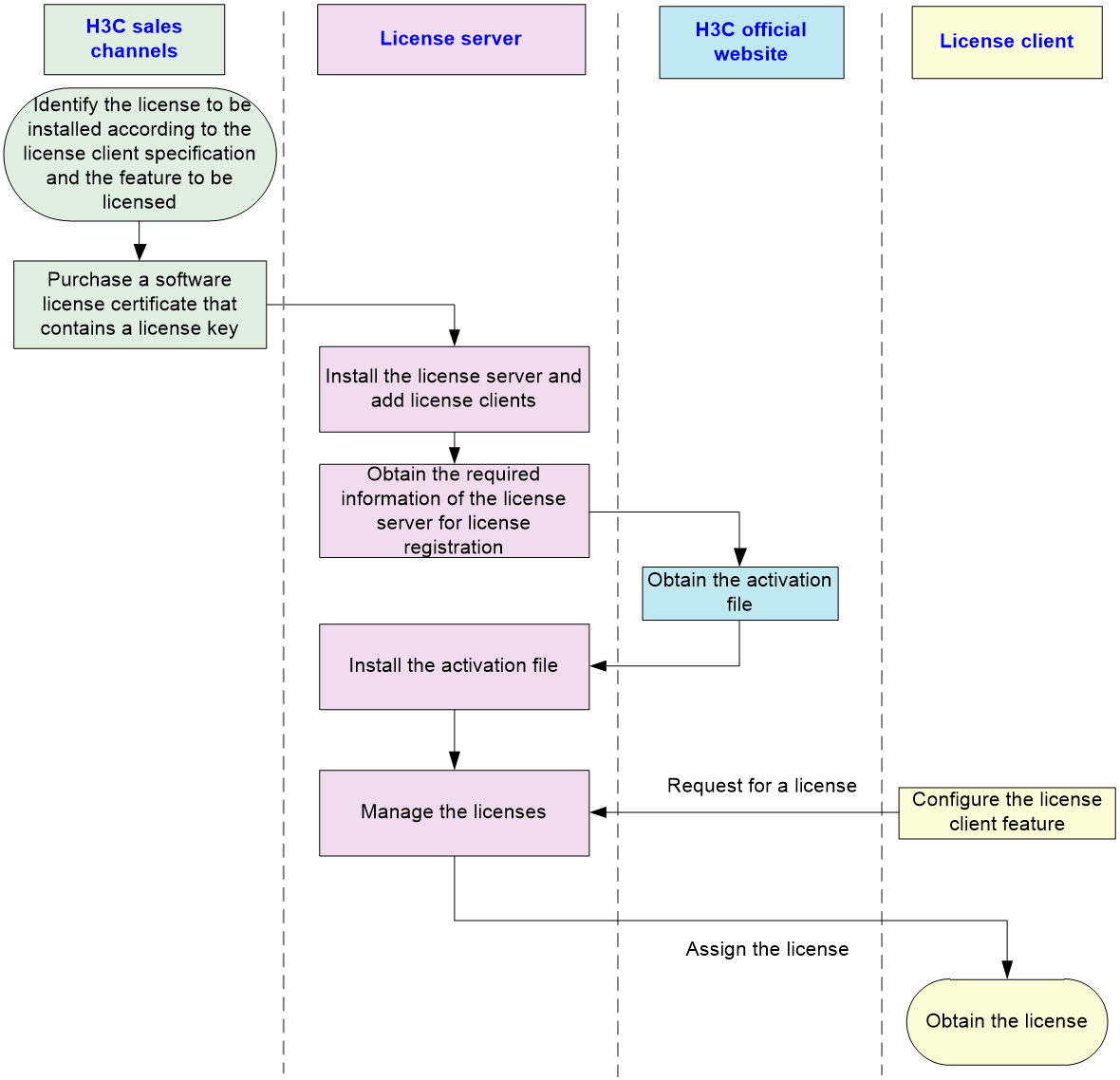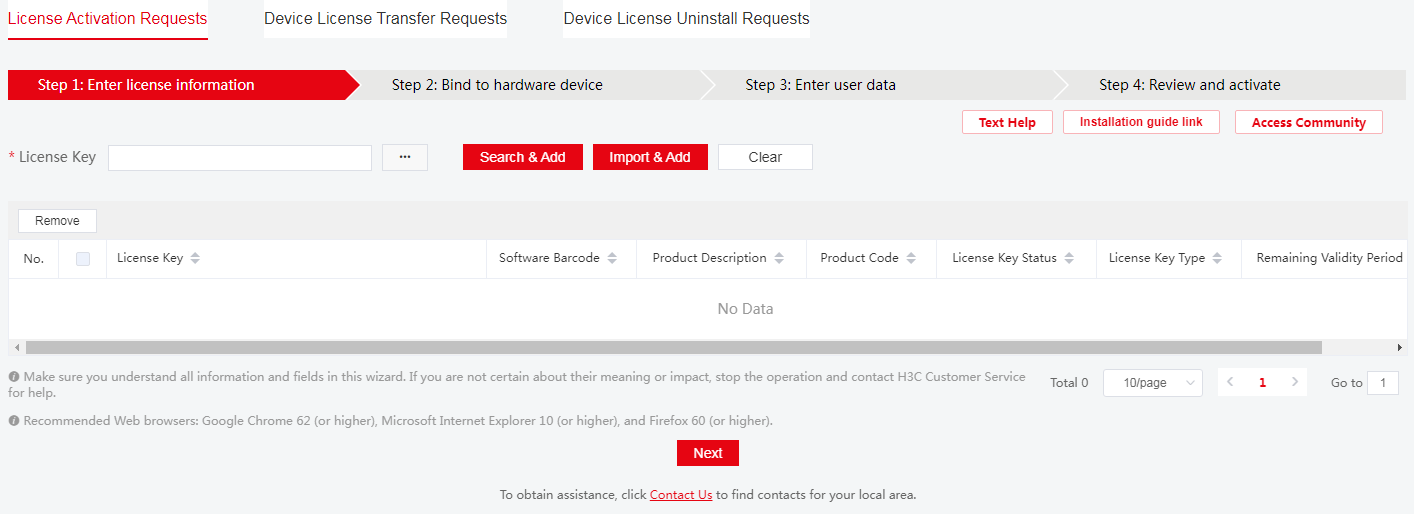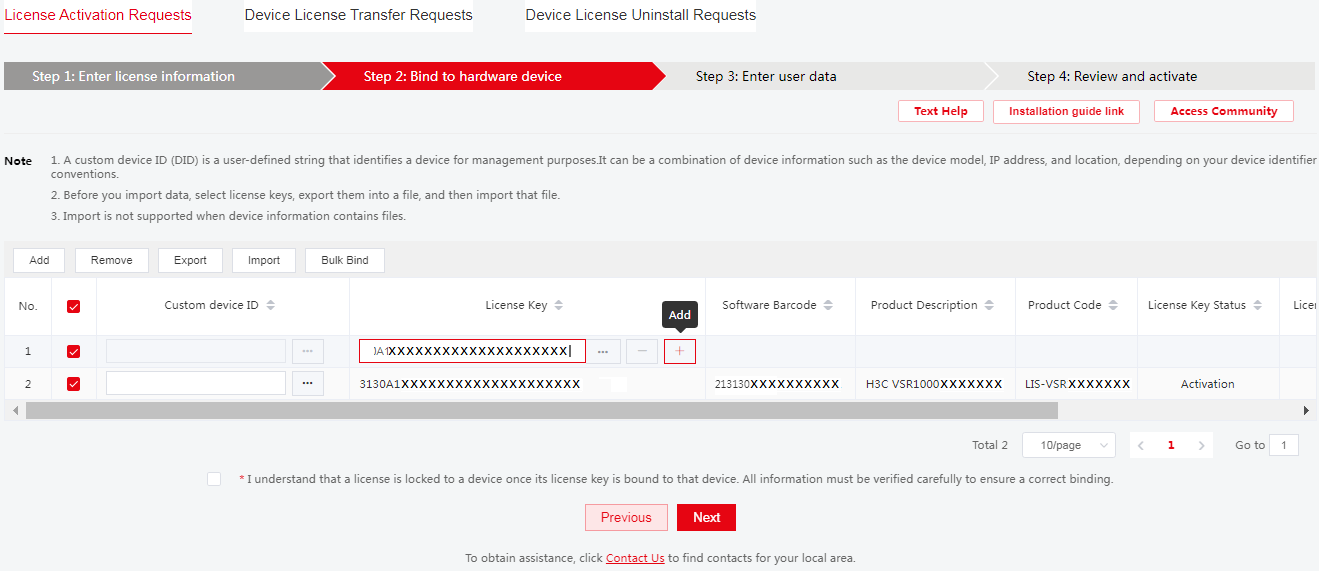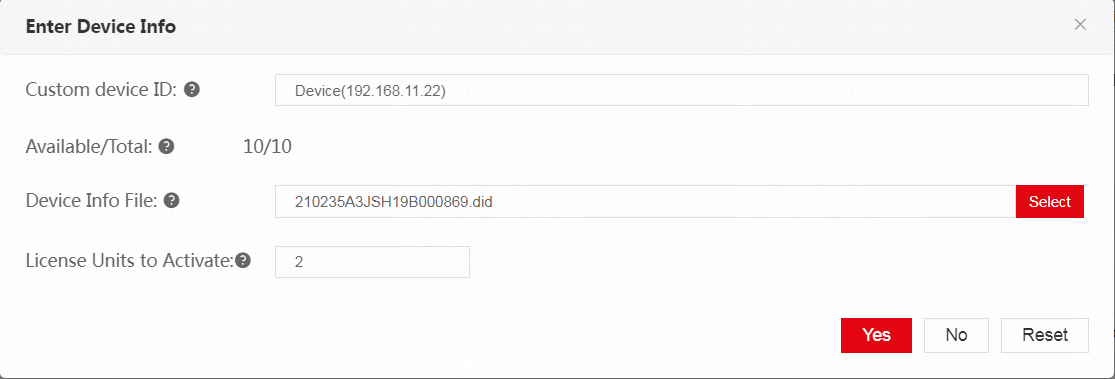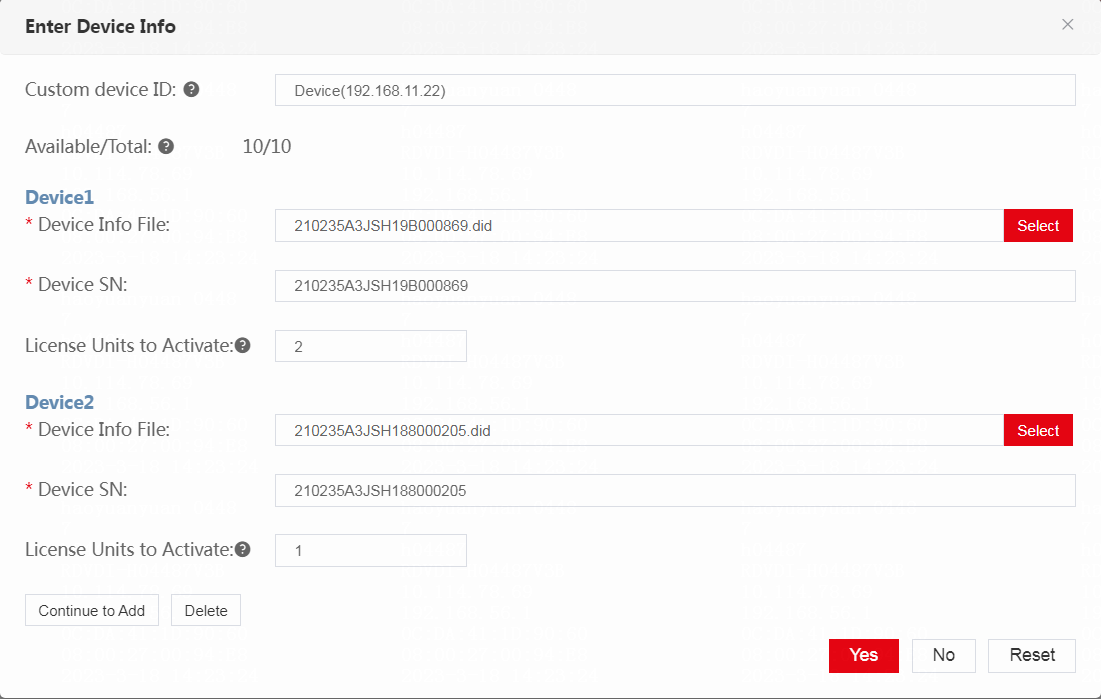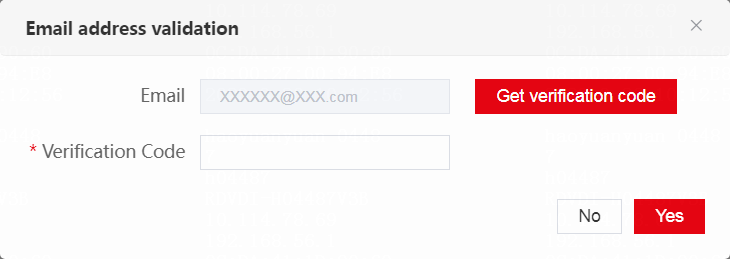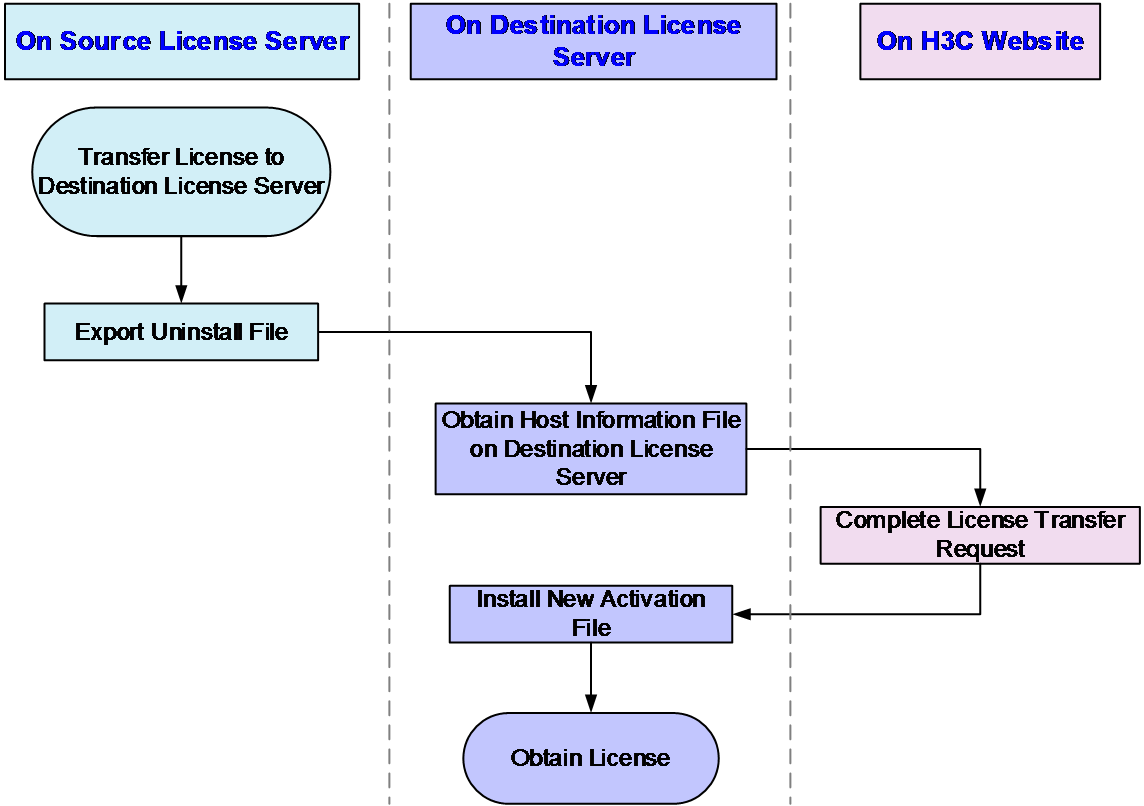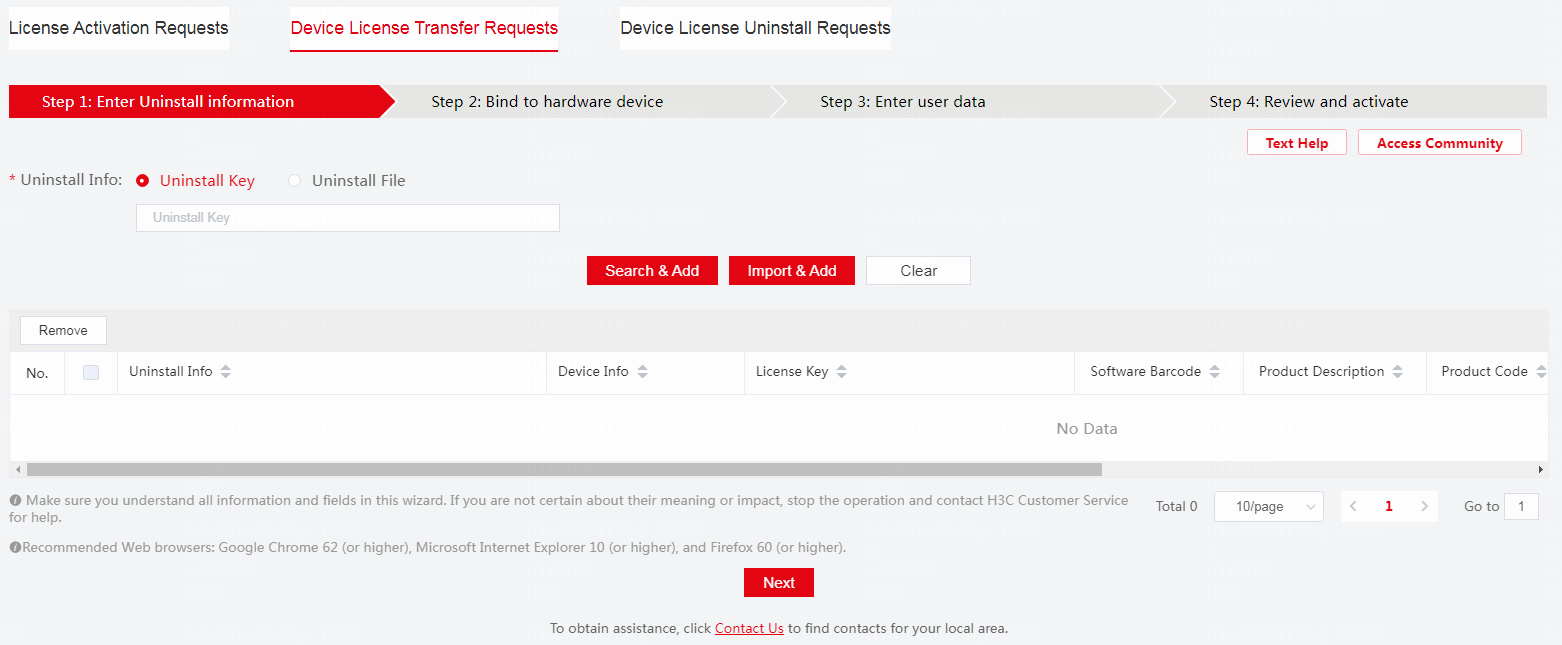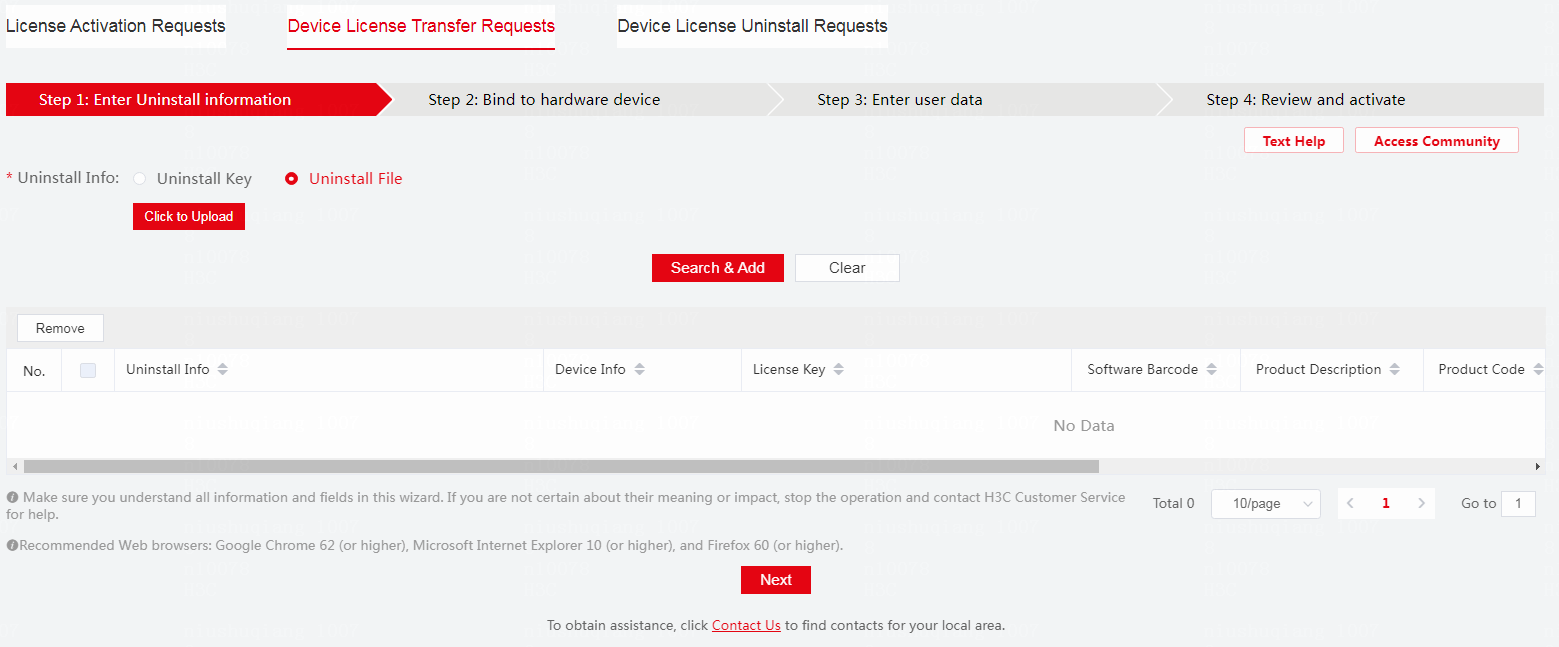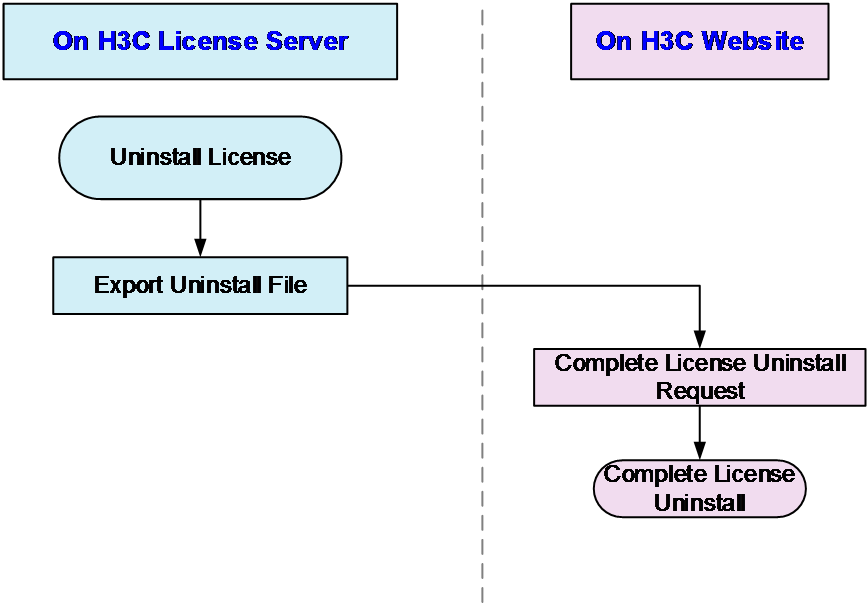- Released At: 12-05-2025
- Page Views:
- Downloads:
- Table of Contents
- Related Documents
-
|
|
|
H3C Switches & Routers |
|
Licensing Guide |
|
|
|
|
Copyright © 2021-2023 New H3C Technologies Co., Ltd. All rights reserved.
No part of this manual may be reproduced or transmitted in any form or by any means without prior written consent of New H3C Technologies Co., Ltd.
Except for the trademarks of New H3C Technologies Co., Ltd., any trademarks that may be mentioned in this document are the property of their respective owners.
The information in this document is subject to change without notice.
Contents
Obtaining information about license-based features
Restrictions and guidelines: Local licensing management
Management operation restrictions and guidelines
Registering and installing a license
License registration and installation flowchart
Identifying the license storage on the device
Compressing the license storage on the device
Obtaining device information from the device
Requesting an activation key or activation file on H3C License Management Platform
Installing an activation key or activation file on the device
Obtaining an Uninstall key or Uninstall file on the source device
Compressing the license storage of the destination device
Obtaining the device information of the destination device
Requesting license transfer on H3C License Management Platform
Installing the new activation key or activation file on the destination device
License uninstallation workflow
Obtaining an Uninstall key or Uninstall file for a license on the device
Requesting license uninstallation on H3C License Management Platform
Local licensing from the Web interface
Restrictions and guidelines: Local licensing configuration
Management operation restrictions and guidelines
Registering and installing a license
License registration and installation flowchart
Compressing the license storage on the device
Obtaining device information from the device
Requesting an activation key or activation file on H3C License Management Platform
Installing an activation key or activation file on the device
Restrictions and guidelines: Remote licensing
Management operation restrictions and guidelines
Registering and installing a license
License registration and installation flowchart
Obtaining the DID file of the license server
Requesting an activation file on H3C License Management Platform
Installing an activation file on the license server
Configuring a license client to obtain licenses from the license server
Obtaining an Uninstall file for a license on the source license server
Obtaining the host information file for the destination license server
Requesting license transfer on H3C License Management Platform
Installing an activation file on the destination license server
License uninstallation workflow
Obtaining an Uninstall file for a license
Requesting license uninstallation on H3C License Management Platform
Q: What is a license key and what is an activation key or activation file?
Q: Can I install the license for a feature only on one member device in an IRF fabric?
Q: Can I modify the system time of the device after a license is installed?
Q: Might the DID file for the device change? What impact does a DID file change have?
Q: How do I deal with an invalid license after a hardware change?
Q: Can I uninstall an expired license?
Q: How do I obtain the Uninstall key for a license?
Q: Can I install an uninstalled activation file on the device again?
Q: How do I delete expired and uninstalled licenses?
Q: What should I do if I inadvertently delete the activation file for a license?
Q: How do I retrieve a lost license key?
Q: How do I retrieve an activation key or activation file?
Q: How do I transfer licenses when a node fails or when license transfer is required?
Overview
H3C offers licensing options for you to deploy features and expand resource capacity on an as needed basis. To use license-based features, you must purchase licenses from H3C and install the licenses.
Obtaining information about license-based features
To obtain information about license-based features, their licensing status, and license availability, execute the display license feature command on the device. Then, you can purchase and install licenses as needed.
Figure 1 displays a sample output from the display license feature command:
Figure 1 Sample output from the display license feature command
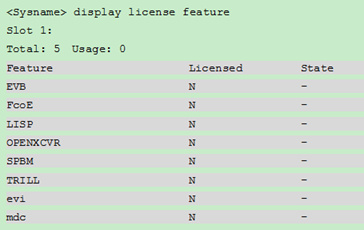
License types
H3C offers preinstalled and formal licenses. Support for preinstalled licenses varies by product. For more information about the license options available for a product, see the license matrixes document for that product.
Preinstalled licenses
Preinstalled licenses are built into a system and are available for use on initial startup of the system. Users do not need to activate them.
A preinstalled license is typically time limited and cannot be uninstalled or transferred.
When a preinstalled license expires, the license-based feature becomes unavailable. To continue to use the feature, you must purchase and install a formal license for it.
Formal licenses
To gain most from a license-based feature, purchase a formal license for it.
Formal licenses have the following types:
· Feature licenses.
· Flexible feature licenses.
· Subscription licenses.
Feature licenses
Feature licenses are available with different validity periods and their support for uninstallation and transfer of formal licenses depends on product model. For more information, see the license matrixes document for the product.
A feature license can be used only on one device.
To install a feature license:
1. Purchase a software license certificate through an official channel.
2. Access H3C License Management Platform, and then enter the license key in the certificate and the required device information to obtain an activation key or activation file.
3. Install the activation key or activation file in the target system.
Flexible feature licenses
Flexible feature licenses are available with different validity periods and their support for uninstallation and transfer of formal licenses depends on product model. For more information, see the license matrixes document for the product.
A flexible feature license can be split for use on multiple devices.
To install a flexible feature license:
1. Purchase a software license certificate through an official channel.
2. Access H3C License Management Platform, and then enter the license key in the certificate and the required device information to obtain an activation key or activation file.
3. Install the activation key or activation file in the target system.
Subscription licenses
When you purchase a feature license or flexible feature license, you must purchase the corresponding subscription license. Subscription licenses are bound to feature licenses or flexible feature licenses.
Subscription licenses do not need to be activated or installed. A subscription license is automatically activated when the corresponding feature license or flexible feature license is activated.
After a subscription license expires, you cannot transfer the corresponding feature license or flexible feature license and cannot split the corresponding flexible feature license. You must purchase a new subscription license to perform those operations.
Subscription licenses are available with different validity periods. For more information, see the license matrixes document for the product.
Concepts
The following information describes the basic concepts that you might encounter when you register, install, and manage licenses.
H3C License Management Platform
H3C License Management Platform provides product licensing services for H3C customers. You can access this system to obtain license activation key or file, transfer licenses, or remove the device and license binding for an uninstalled license.
H3C License Management Platform is accessible at https://www.h3c.com/en/Support/Online_Help/License_Service/.
Software license certificate
A software license certificate allows users to use a license-based feature. It contains license key, license capacity, and other information.
License key
A license key uniquely identifies a license.
To obtain a formal license key, purchase a software license certificate. The authorization serial number in the software license certificate is the license key.
Device serial number
A device serial number (SN or S/N) is a barcode that uniquely identifies a device. It comes with the device and must be provided when you request a license in H3C License Management Platform.
Device ID (DID) and DID file
A DID is a string of characters that uniquely identifies a hardware device. A DID file stores the DID and other information. The product comes with a DID or DID file. You must provide the DID or DID file when you request a license for the device on H3C License Management Platform.
A DID file is also referred to as a device information file in this document.
Activation key and activation file
An activation key (AK) or activation file (AF) binds a license to a system.
To use a license-based feature on a system, you must perform the following tasks:
1. Use the license key and the system’s SN and DID information to obtain an activation key or file from H3C License Management Platform.
2. Install the activation key or file on the system.
Uninstall key and Uninstall file
When you uninstall an activation key or file, the system generates an Uninstall key (UK) or Uninstall file (UF), respectively. This information proves that the license and system binding has been removed. You must provide this information when you transfer an unexpired license from one system to another.
License storage
License storage is a persistent storage of fixed size for storing licensing information. This information includes the licensing state, licensing time, Uninstall key or file, and other related information.
Data in the license storage persists through reboot. This ensures licensing accuracy and continuity.
Stateful failover deployment
A failover deployment contains one master node and one backup node for node redundancy.
In a stateful failover deployment, the backup node instantly backs up data from the master node so the master can take over immediately after the master node fails.
Stateful failover is also called management high availability (HA) or hot backup. The master and backup nodes in a failover pair are also called primary and secondary nodes, respectively.
Licensing methods
The system supports local licensing and remote licensing.
· With local licensing, you install and manage licenses on the device.
· With remote licensing, you install and manage licenses on a license server, which allocates licenses to its license clients (nodes on the network).
Local licensing is suitable for small-sized networks, and remote licensing is suitable for large-sized networks, as shown in Table 1.
To identify the support of your device for the licensing methods, verify the availability of the following commands:
· If the display license device-id command is available, the product supports local licensing.
· If the display license device client command is available, the product supports remote licensing.
· If both commands are available, the product supports both local licensing and remote licensing.
|
Licensing method |
License installed on |
License used on |
Applicable scenarios |
|
Local licensing |
Local device |
Local device |
Applicable to small-sized network. You must activate licenses device by device. |
|
Remote licensing |
H3C license server |
License clients |
Applicable to large-sized network. You activate licenses on the license server, which then automatically assigns licenses to its clients either proactively or on request. On each license client, you need to configure the parameters for the client to connect to the license server to obtain licenses. |
Technical support
To obtain assistance, contact H3C by email or phone or access documents at the H3C website.
· Email:
¡ China: [email protected]
¡ Hong Kong, China: [email protected]
¡ Other countries or regions: [email protected]
· Technical support hotline:
To find contacts for your local area, access the H3C global contacts page at https://www.h3c.com/en/Support/Online_Help/Service_Hotlines/
· Website: http://www.h3c.com
Local licensing from the CLI
|
IMPORTANT: The command output in this document is for illustration only. The actual command output varies by device model. |
About local licensing
Local licensing requires license activation device by device. It is applicable to small-sized networks.
To install a license on a device:
1. Obtain the license key and the SN and DID information of the device.
2. Access H3C License Management Platform to request an activation key or activation file based on the license key and the device's SN and DID information.
3. Install the activation key or activation file on the device to activate the license.
The activation key or file for a license is device locked. You cannot install the activation key or activation file for one device to activate the license on another device.
Figure 2 Licensing procedure
Restrictions and guidelines: Local licensing management
Management operation restrictions and guidelines
· Purchase licenses from H3C authorized channels.
· To identify the validity periods of the licenses that have been installed on the device, execute the display license command. If the license for a feature is time limited, install a new license for the feature before the old license expires.
Figure 3 Sample output from the display license command
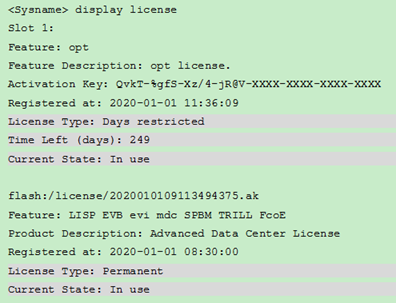
· Licenses are typically device locked. To ensure a successful licensing, use the following licensing guidelines:
a. When you purchase a license certificate, verify the following items:
- Make sure the license is compatible with the target device.
- Make sure its licensed functionality and capacity meet your requirements.
b. When you obtain an activation key or file, make sure the provided license key and hardware information are correct.
c. Install the activation key or file on the correct target device.
· Make sure no one else is performing license management tasks while you are managing licenses on the device.
· Unless otherwise stated, all character strings entered on H3C License Management Platform are case sensitive. As a best practice to ensure a successful licensing, copy and paste license keys, Uninstall keys, device SNs, and values for other critical fields as long as possible.
· You can manage licenses only on the default MDC. Any license operation performed on the default MDC takes effect on all MDCs.
File operation restrictions
When you operate DID files, activation files, or Uninstall files, follow these restrictions and guidelines:
· To avoid licensing error, do not modify the file name or edit the file content.
· Before you install an activation file, download the activation file to the storage media of the device such as flash memory or CF card. When installing an activation file, the device automatically copies the activation file to the license folder in the root directory of the storage media. The license folder stores important files for licensing. For licensed features to function correctly, do not delete or modify the license folder or the files in this folder.
Registering and installing a license
License registration and installation flowchart
Figure 4 shows the procedure for registering and installing a formal license.
Licensing requirements
Single-node deployment
Licenses for fixed-port devices are device locked (also called chassis locked). You purchase, register, and install licenses on a per-device basis.
Licenses for modular devices are device locked or MPU locked, depending on the device series. To identify the license locking type, execute the display license feature command.
· If the command output does not contain slot fields, the license is device locked. Use the following guidelines:
¡ You purchase licenses and install their activation files on a per-device basis.
¡ When you install an activation file, the system automatically copies the activation file to all MPUs of the device.
- The licensed feature can operate correctly after you remove one of the MPUs.
- If you replace one of the MPUs, the system automatically copies all activation files to the new MPU to make sure the licensed features can operate correctly after an active/standby switchover.
- If you are replacing both MPUs at the same time, back up the activation files. After the replacement, you must copy the activation files back to the new active MPU for the licensed features to continue to take effect. The system will automatically copy the activation files to the standby MPU.
Figure 5 Command output without the slot field
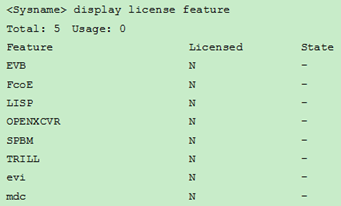
· If the command output contains slot fields, in Slot xx or Chassis xx Slot xx format, the licenses are MPU locked. Use the following guidelines:
¡ You purchase, register, and activate licenses of the same specifications for each MPU in the device. This ensures that the license-based features can continue to take effect after an active/standby switchover.
¡ If you move the MPUs to another device, the license-based features can continue to take effect on the destination device as long as they are still valid. To have the license-based features continue to take effect on the source device, you must purchase, register, and activate new licenses for the new MPUs.
Figure 6 Command output with slot fields
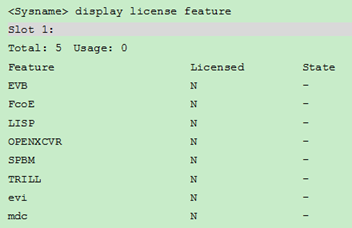
IRF or 1+N node redundancy deployment
In an IRF or 1+N node redundancy deployment, only the licenses installed on the current master node are used. For a license-based feature to take effect after a master/standby switchover, you must purchase, apply for, and install a license of the same specification on each of the member node or IRF member device. The license installation requirements and license installation procedures are the same across the member devices.
1+N node redundancy deployment contains one master device and N backup devices, for example, a stateful failover deployment. The master device processes services. When the master device fails, a backup device immediately takes over to ensure service continuity.
Command syntaxes
|
IMPORTANT: The command syntaxes in this document are for illustration only. The complete command syntaxes vary by device model. |
Table 2 shows the command syntaxes for the command used to install licenses on fixed-port devices and modular devices.
Table 2 Syntaxes for the command used to install licenses
|
Device type |
Command syntax |
|
Fixed-port devices that do not support IRF |
license activation-file install activation-file |
|
Fixed-port devices that support IRF |
license activation-file install activation-file slot slot-number |
|
Modular devices where licenses are device locked |
In standalone mode: license activation-file install activation-file In IRF mode: license activation-file install activation-file chassis chassis-number |
|
Modular devices where licenses are MPU locked |
In standalone mode: license activation-file install activation-file slot slot-number In IRF mode: license activation-file install activation-file chassis chassis-number slot slot-number |
Obtaining a license key
After you obtain a license key, back up it and keep the backup license key in a safe place for future use.
To obtain a license key:
1. Log in to the CLI of the device and execute the display license feature command in any view to identify features that require licensing.
Figure 7 Sample output from the display license feature command
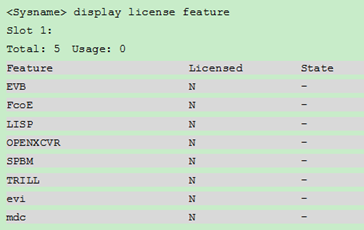
2. To use a license-based feature, purchase a software license certificate for it. The authorization serial number in the software license certificate is the license key.
Identifying the license storage on the device
To identify the free space of the license storage, execute the display license feature command in any view.
From the command output, view the Total and Usage fields to examine whether the remaining license storage is sufficient for installing new licenses. If the remaining license storage is not sufficient, compress the license storage.
Figure 8 Identifying the license storage
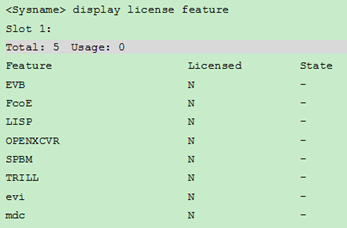
Compressing the license storage on the device
About this task
The license storage stores licensing information and has a fixed size.
Before requesting an activation key or activation file, you compress the license storage to delete expired and uninstalled license information to ensure sufficient storage space for installing new licenses.
If no licenses have been installed on the device, you do not need to compress the license storage.
Restrictions and guidelines
Back up the Uninstall keys or Uninstall files for the uninstalled licenses for subsequent license transfer or license uninstallation on H3C License Management Platform.
If uninstalled licenses or expired licenses exist on the device, the compression operation will make the DID change. You will be unable to install the activation key or activation file obtained by using the old DID on the device. As a best practice, install all activation keys or activation files registered with the old DID before performing a compression.
If you have not installed an activation key or activation file registered with the old DID, take the following actions:
· If the license storage is sufficient, install the activation key or activation file on the device. For more information, see "Installing an activation key or activation file on the device."
· If the license storage is insufficient and the activation key or activation file cannot be installed after the compression, contact H3C Support.
Procedure
1. Execute the system-view command to enter system view.
2. Execute the license compress command to compress the license storage.
Obtaining device information from the device
Device information is required for license registration on H3C License Management Platform.
To obtain required information for license registration from CLI, log in to the CLI of a device and obtain the following parameters:
· H3C device SN—You can execute the display license device-id command in any view to obtain the value of the SN field.
· DID or DID file—You can execute the display license device-id command in any view to obtain the value of the Device ID field.
¡ If the field value is a string of characters, the device supports the DID. You can copy the DID for future use.
Figure 9 Obtaining the DID

¡ If the field value is a file name, the device supports the DID file. Use FTP or TFTP to upload the DID file to the PC. If FTP is used to transfer the DID file, use the Binary mode.
Figure 10 Obtaining the DID file

Requesting an activation key or activation file on H3C License Management Platform
About this task
On H3C License Management Platform, you can use one of the following methods to request an activation key or activation file:
· Bind one license key to one device in one request.
· Bind multiple license keys to one device or multiple devices in one request.
Adding license keys
1. Open a Web browser and access H3C License Management Platform at https://www.h3c.com/en/Support/Online_Help/License_Service/.
|
IMPORTANT: As a best practice, use Chrome 62 or above, IE 10 or above, or Firefox 60 or above. |
2. Access the License Activation Requests page as shown in Figure 11.
Figure 11 License Activation Requests page
3. Use one of the following methods to add license keys:
¡ To add license keys one by one:
# Enter or copy and paste a complete license key in the empty License Key box as shown in Figure 11, and then click Search & Add. The platform will automatically obtain the information associated with the license key.
# Repeat this step to add multiple license keys.
¡ To add license keys by uploading the QR code images for the license keys:
# Click the ![]() icon next to the License
Key box as shown in Figure 11,
and then upload the QR code image for a license key as shown in Figure 12.
icon next to the License
Key box as shown in Figure 11,
and then upload the QR code image for a license key as shown in Figure 12.
# Click Search & Add in Figure 11. The platform will automatically obtain the information associated with the QR code image.
# Repeat this step to add multiple license keys.
|
IMPORTANT: Make sure the uploaded image is complete and clear for the platform to correctly recognize it. |
Figure 12 Uploading the QR code image for a license key
¡ To add license keys in bulk.
# As shown in Figure 11, click Import & Add.
# In the dialog box that opens, you can use one of the following methods to import license keys in bulk to H3C License Management Platform:
- Click the Download Excel License Key Import Template link to download the Excel license key import template, as shown in Figure 13. The contents in the template are as shown in Figure 14. Enter license keys in the template, save the template, and then upload it to the platform. The license keys in the template are all imported to the platform.
- Click Select as shown in Figure 13 to upload a license key list file to the platform if an electronic license key list file is available. The license keys in the file are all imported to the platform.
Figure 14 Contents in the Excel license key import template
4. Select license keys to be activated, and then click Next, as shown in Figure 15.
Figure 15 Finishing adding license keys
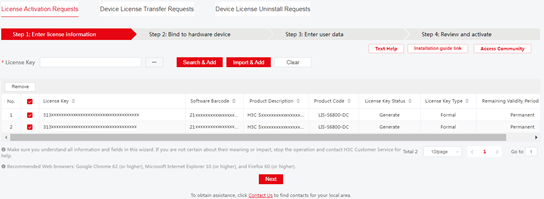
Binding license keys to devices
1. Verify that the license keys to be activated are all added.
¡ To add a license key on the page as shown in Figure 16:
- Click Add.
- Enter or copy and paste a complete license key in the License Key column, or click the ![]() icon in the column to upload the QR code image for
a license key.
icon in the column to upload the QR code image for
a license key.
- Click the plus icon (+) to add the license key.
¡ To remove a license key, select that license key, and then click Remove.
Figure 16 Adding or removing license keys
2. (For feature licenses.) Enter device information as instructed by H3C License Management Platform:
To obtain device information, use the method as described in "Obtaining device information from the device."
Use one of the following methods to bind license keys to devices:
¡ To bind one license key to one device:
# Click the ![]() icon next
to the Custom
device
ID box in the license key entry, as shown in Figure 16.
icon next
to the Custom
device
ID box in the license key entry, as shown in Figure 16.
# In the dialog box that opens, set the device ID and upload the device information file of the device as instructed, and then click Yes.
Figure 17 Entering device information

# Repeat the steps to bind multiple license keys to different devices.
¡ To bind multiple license keys to the same device:
# Select the license keys on the page as shown in Figure 16, and then click Bulk Bind.
# In the dialog box that opens, set the device ID, upload the device information file of the device, and then click Yes.
¡ To add license key and device bindings in bulk:
- Select the target license keys as shown in Figure 16, and then click Export to export the selected license keys to an excel file.
- Open the excel file, and then enter device information for each license key.
- Click Import to import the Excel file.
|
IMPORTANT: · The custom device ID field is optional. The value for this field is user defined, and it is used to identify a device. As a best practice to facilitate device management and location, use the combination of the device model, IP address, physical position, and other information as the custom device ID. This custom device ID takes effect only on the current license activation request. It cannot take effect after you leave the license activation request page and re-open the page. If you do not define a custom device ID, the device automatically defines it. · When you add license key and device bindings in bulk, some devices do not support importing or exporting device information because they require device information files for license key binding. The exported Excel file contains information to help you identify such devices. |
3. (For flexible feature licenses.) Enter device information as instructed by H3C License Management Platform:
To obtain device information, use the method as described in "Obtaining device information from the device."
To split one license key for use on multiple devices:
# Click the ![]() icon next
to the Custom
device
ID box in the license key entry, as shown in Figure 16.
icon next
to the Custom
device
ID box in the license key entry, as shown in Figure 16.
# In the dialog box that opens, set the device ID, upload the device information file of the device, and enter the number of license units to be activated, and then click Yes.
Figure 18 Entering device information
# Configure the same parameters for a second device, as shown in Figure 19.
# To enter device information for more devices, click Continue to Add, and click Yes.
Figure 19 Enter device information for more devices
|
IMPORTANT: The custom device ID field is optional. The value for this field is user defined, and it is used to identify a device. As a best practice to facilitate device management and location, use the combination of the device model, IP address, physical position, and other information as the custom device ID. This custom device ID takes effect only on the current license activation request. It cannot take effect after you leave the license activation request page and re-open the page. If you do not define a custom device ID, the device automatically defines it. |
4. Review the bindings carefully.
Each license key will be locked to the device to which each of them is bound.
5. Make sure you understand the impact of the binding operation. Select the option that explicitly states so, and then click Next, as shown in Figure 20.
Figure 20 Finishing binding license keys to devices
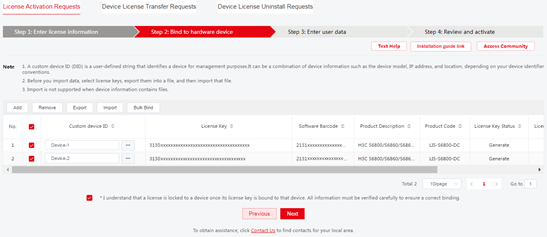
Specifying user information
As shown in Figure 21, enter user information, and then click Next. Table 3 describes the parameters.
If the entered email address is used for the first time on the platform, the platform displays the Email address validation page, as shown in Figure 22. Click Get verification code, and the platform will send a test mail to the specified email address. Enter the verification code in the test mail in the Verification Code field, and click Yes complete the verification.
Figure 21 Entering user information
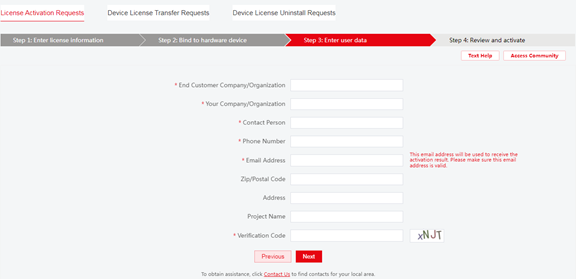
Table 3 User information configuration parameters
|
Parameter |
Description |
|
End Customer Company/Organization |
(Required.) Company or organization that uses the licenses. |
|
Your Company/Organization |
(Required.) Company or organization with which the license applicant works. |
|
Contact Person |
(Required.) Name of the contact person. |
|
Phone Number |
(Required.) Contact phone number. |
|
Email Address |
(Required.) Contact email address. H3C License Management Platform will send the generated activation keys or activation files to this email address. Make sure the email address is correct and available. |
|
Zip/Postal Code |
(Optional.) Zip code or postal code for the contact address. |
|
Address |
(Optional.) Contact address. |
|
Project Name |
(Optional.) Project name. |
|
Verification Code |
(Required.) The verification code is case insensitive. |
Figure 22 Email address valiation page
Reviewing information and activating the licenses
1. Review the license key and device information, select I accept all terms and conditions of H3C License Service Portal Legal Statement, and then click Confirm & Activate, as shown in Figure 23.
Figure 23 Reviewing information and activating the licenses

2. Double-check the license key and device information, and then click OK in the dialog box as shown in Figure 24.
Figure 24 Confirmation dialog box

The platform automatically generates an activation key or activation file for each binding and sends them to the specified email address.
3. Perform one of the following tasks to obtain activation keys or activation files:
¡ If one license key is bound to one device, the platform generates an activation file for the device. To download the activation file, click Get Activation Info in the Get Activation Info column for the license key, as shown in Figure 27.
¡ If multiple license keys are bound to one device, the platform generates a compressed activation file package for the device. To download the compressed activation file package, click Get Activation Info in the Get Activation Info column shared by the license keys.
¡ To obtain all activation files generated for this request, click Bulk Get Activation Info as shown in Figure 27. The activation files are as shown in Figure 25 and the activation information sheet is as shown in Figure 26.
|
IMPORTANT: As a best practice, click Bulk Get Activation Info to obtain all activation files generated for this request. The activation information sheet provided by this method facilitates you to record and manage activation files. |
Figure 25 License file information

Figure 26 Activation information sheet
![]()
¡ Access the email box at the specified address to obtain the activation keys or activation files.
Figure 27 Downloading activation files
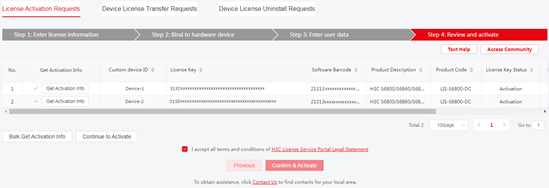
|
IMPORTANT: · It takes some time for H3C License Management Platform to generate multiple activation files. In this scenario, you cannot download the activation files from the webpage. To obtain the activation files, you must access the email box at the specified address. · If you do not receive an activation key or activation file for a license key from the platform and cannot use the license key to re-apply for license activation, contact H3C Support. |
Installing an activation key or activation file on the device
About this task
|
CAUTION: Back up an activation key or activation file before you install it. If the activation key or activation file is inadvertently deleted or becomes unavailable for some other reason, you can use the backup activation key or activation file to restore the license. |
To use a license-based feature, install an activation file for the feature on the device.
Prerequisites
Use FTP or TFTP to upload the activation file to be installed to the device. If FTP is used to transfer the activation file, set it in binary mode.
Procedure
1. Execute the system-view command to enter system view.
2. Execute the license activation-file install command to install the activation file.
Viewing license information
Use one of the following commands in any view to display license information:
· Use the display license feature command to display brief license information for features.
Figure 28 Sample output from the display license feature command
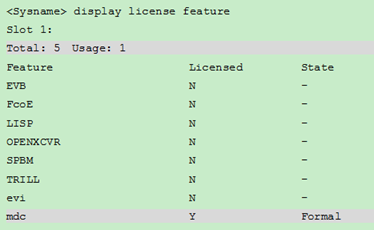
· Use the display license command to display detailed information about licenses, including:
¡ Information about the licensed features, the validity periods of the installed licenses, and the date and time when the licenses were installed.
¡ Information about the features whose licenses were uninstalled, date and time when the licenses were installed, date and time when the licenses were uninstalled, and the Uninstall keys.
Figure 29 Sample output from the display license command
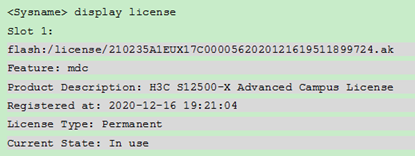
Transferring licenses
About this task
Perform this task to transfer a license that has not expired from one device to another in the same product series.
For the support of the product for license transfer, see its license matrixes document.
License transfer workflow
To transfer licenses from one device to another, use the workflow in Figure 30.
Figure 30 License transfer workflow
Restrictions and guidelines
You can transfer only formal licenses that have not expired.
Obtaining an Uninstall key or Uninstall file on the source device
1. Log in to the CLI of the source device.
2. Execute the display license command to identify the activation key or activation file that will be uninstalled.
Figure 31 Sample output from the display license command
3. Execute the system-view command to enter system view, and perform one of the following tasks to uninstall the license:
¡ If an activation key is installed for the license, execute the license activation-key uninstall command to uninstall the activation key.
¡ If an activation file is installed for the license, execute the license activation-file uninstall command to uninstall the activation file.
4. Execute the display license command to obtain the Uninstall key. Copy the Uninstall key, and then use the Uninstall key on H3C License Management Platform to request a license transfer or uninstallation.
Figure 32 Sample output from the display license command
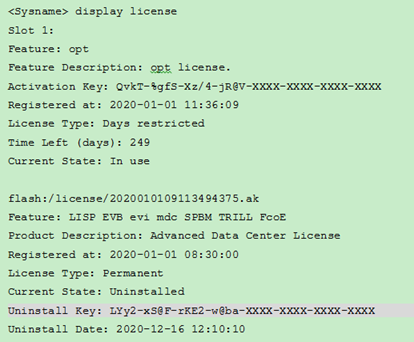
Compressing the license storage of the destination device
To ensure a successful license transfer, verify that the destination device has sufficient license storage space. If the license storage space on the destination device is insufficient, compress the license storage. For more information, see "Identifying the license storage on the device" and "Compressing the license storage on the device."
Obtaining the device information of the destination device
Log in to the destination device, and obtain information as described in "Obtaining device information from the device."
Requesting license transfer on H3C License Management Platform
Entering Uninstall information
1. Open a Web browser and access H3C License Management Platform at https://www.h3c.com/en/Support/Online_Help/License_Service/.
|
IMPORTANT: As a best practice, use Google Chrome 62 (or higher), Microsoft Internet Explorer 10 (or higher), Mozilla Firefox 60 (or higher). |
2. Click the Device License Transfer Requests tab.
If you have not logged in to the system, the Log In page opens. Enter your account information and log in to the system as instructed. This prevents unauthorized license transfer, protects asset security, and ensures traceability of transfer operations.
Upon a successful login, you are redirected to the Device License Transfer Requests page, as shown in Figure 33.
|
|
NOTE: Finish license transfer within 4 hours after you access the license transfer request page. If you fail to do that, the system will request you to log in again and automatically return to the first application step. |
Figure 33 Device License Transfer Requests page
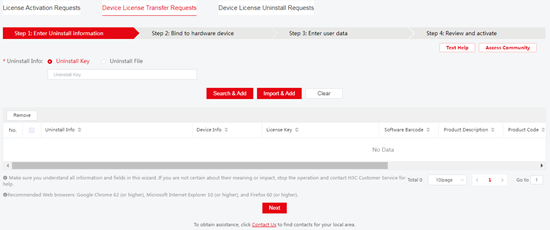
3. As shown in Figure 34, select Uninstall File, click Click to Upload to upload the Uninstall files, and then click Search & Add.
For information about obtaining Uninstall files, see "Obtaining an Uninstall key or Uninstall file on the source device."
Figure 34 Uploading the Uninstall files
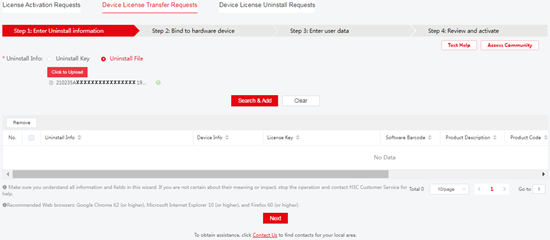
4. Select entries to uninstall, and then click Next.
Figure 35 Finishing adding Uninstall files
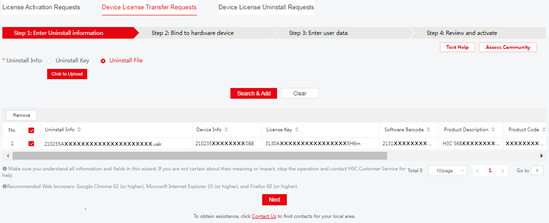
Binding license keys to the destination device
1. Review the Uninstall files on the Bind to hardware device page.
To remove an Uninstall file, select that Uninstall file and click Remove.
Figure 36 Bind to hardware device page
2. Bind the uninstallation information of the source device to the destination device. Make sure you understand the impact of the binding operation, and then select the option that explicitly states so.
3. Click Next. For more information, see "Binding license keys to devices."
Figure 37 Finishing binding license keys to devices
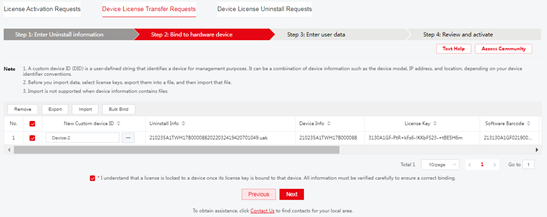
Entering user information
Enter user information, and then click Next. For more information, see "Specifying user information."
Reviewing information and activating the licenses
Review and activate the license to obtain a new activation key or activation file. For more information, see "Reviewing information and activating the licenses."
Figure 38 Succeeding in requesting license transfer

Installing the new activation key or activation file on the destination device
|
CAUTION: Before you install an activation key or activation file, back up and keep your activation key or activation file safe. If the activation key or activation file is deleted or the license is unavailable because of device failure, you can use the backup activation key or activation file to restore the license. |
Log in to the destination device and install the new activation key or activation file on the destination device. For more information, see "Installing an activation key or activation file on the device."
Uninstalling a license
About this task
A license key is bound to a device once you activate the license key on H3C License Management Platform. You cannot bind this license key to another device. To unbind a license key for a license that has not expired from a device, obtain the Uninstall key or Uninstall file for the license on the device. Then, request for license uninstallation on H3C License Management Platform.
After license uninstallation is requested successfully, you can use this license key to request a new activation key or activation file on H3C License Management Platform.
The new activation key or activation file can be installed on another device for license transfer or on the local device for license restoration.
For support of license uninstallation, see the license matrixes for the product.
License uninstallation workflow
Figure 39 Uninstallation workflow
Restrictions and guidelines
You can uninstall only formal licenses that have not expired.
Obtaining an Uninstall key or Uninstall file for a license on the device
Log in to the device to obtain an Uninstall key or Uninstall file for a license. For more information, see "Obtaining an Uninstall key or Uninstall file on the source device."
Requesting license uninstallation on H3C License Management Platform
|
CAUTION: If you cannot obtain an Uninstall key or Uninstall file because of device failure, contact H3C Support to unbind the device from the license. |
To request license uninstallation on H3C License Management Platform:
1. Log in to H3C License Management Platform at https://www.h3c.com/en/Support/Online_Help/License_Service/.
2. Click the Device License Uninstall Requests tab.
If you have not logged in to the system, the Log In page opens. Enter your account information and log in to the system as instructed. This prevents unauthorized license uninstallation, protects asset security, and ensures traceability of the uninstallation operations.
Upon a successful login, you are redirected to the Device License Uninstall Requests page.
|
|
NOTE: Finish license uninstallation within 4 hours after you access the license uninstall request page. If you fail to do that, the system will request you to log in again and automatically return to the first application step. |
Figure 40 Device License Uninstall Requests page
3. Use one of the following methods to enter uninstallation information:
¡ Manually enter Uninstall keys one by one and click Search & Add to obtain uninstallation information.
¡ Import Uninstall keys in bulk. First, click Import & Add and download the Excel Uninstall key import template. Then, enter Uninstall keys in the template and upload the Excel file back to H3C License Management Platform to obtain uninstallation information.
For information about obtaining Uninstall keys, see "Obtaining an Uninstall key or Uninstall file on the source device."
4. Select the uninstallation information that will be uninstalled.
5. Click Next.
6. Enter user information, and then click Next. For more information, see "Specifying user information."
7. Review the uninstallation information, and then select the option that explicitly states your acceptance of all terms in the legal statement.
8. Click Confirm & Uninstall.
9. Review license and device information, and then click OK. The binding between the device and license key will be removed.
Local licensing from the Web interface
|
IMPORTANT: The webpage output in this document is for illustration only. The actual webpage output varies by device model. |
About local licensing
For more information, see "About local licensing" in licensing from the CLI.
Restrictions and guidelines: Local licensing configuration
Management operation restrictions and guidelines
· Purchase licenses from H3C authorized channels.
· Licenses are typically device locked. To ensure a successful licensing, use the following licensing guidelines:
a. When you purchase a license certificate, verify the following items:
- Make sure the license is compatible with the target device.
- Make sure its licensed functionality and capacity meet your requirements.
b. When you obtain an activation key or file, make sure the provided license key and hardware information are correct.
c. Install the activation key or file on the correct target device.
· Make sure no one else is performing license management tasks while you are managing licenses on the device.
· Unless otherwise stated, all character strings entered on H3C License Management Platform are case sensitive. As a best practice to ensure a successful licensing, copy and paste license keys, Uninstall keys, device SNs, and values for other critical fields as long as possible.
· You can manage licenses only on the default MDC. Any license operation performed on the default MDC takes effect on all MDCs.
File operation restrictions
For more information, see "File operation restrictions" in local licensing from the CLI.
Registering and installing a license
License registration and installation flowchart
For information about the procedure for registering and installing a license, see "License registration and installation flowchart" in local licensing from the CLI.
Licensing requirements
For information about licensing requirements, see "Licensing requirements" in local licensing from the CLI.
Obtaining license keys
Restrictions and guidelines
|
CAUTION: Back up your license keys, and keep the backup license keys in a safe place for future use. |
Procedure
1. Log in to the Web interface of the device.
2. From the navigation pane, select System Tool > License Management.
3. Click the Licenses and features tab. On the page that opens, identify the features that require licenses.
Figure 41 Identifying the features that require licenses
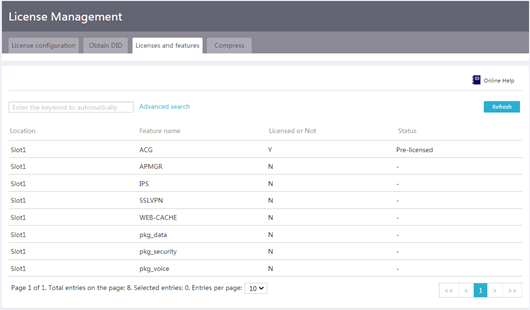
4. Purchase software license certificates from H3C authorized channels. The software license certificates contain license keys.
Compressing the license storage on the device
About this task
The license storage stores licensing information and has a fixed size.
You compress the license storage to delete expired and uninstalled license information to ensure sufficient storage space for installing new licenses.
If no licenses have been installed on the device, you do not need to compress the license storage.
To identify whether a compression operation is required:
1. Log in to the Web interface of the device.
2. From the navigation pane, select System Tool > License Management.
3. Click the Compress tab.
4. Calculate the remaining number of allowed license files (activation files). Remaining number of allowed license files = Total number of allowed license files – Number of installed license files.
¡ If the remaining number of allowed license files is smaller than the number of license files to be installed, you must compress the license storage.
¡ If the remaining number of allowed license files is not smaller than the number of license files to be installed, you do not need to compress the license storage.
Figure 42 Compress page
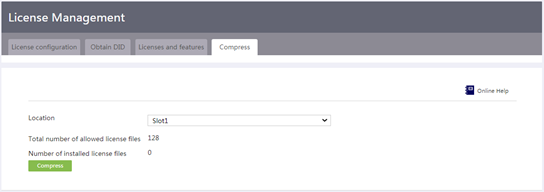
Restrictions and guidelines
For more information, see the restrictions and guidelines in "Compressing the license storage on the device."
Procedure
1. Log in to the Web interface of the device.
2. From the navigation pane, select System Tool > License Management.
3. Click the Compress tab.
4. On the page that opens, click Compress.
5. Click Apply.
Obtaining device information from the device
About this task
Device information is required for license registration on H3C License Management Platform.
Procedure
1. Log in to the Web interface of the device.
2. From the navigation pane, select System Tool > License Management.
3. Click the Obtain DID tab.
4. Obtain the device SN and DID and copy them for future use.
Figure 43 Obtaining the device SN and DID
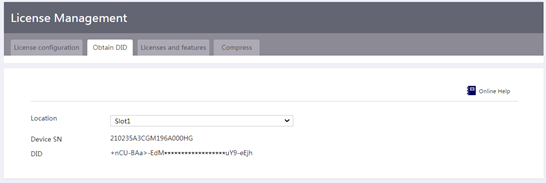
Requesting an activation key or activation file on H3C License Management Platform
For more information, see "Requesting an activation key or activation file on H3C License Management Platform" in local licensing from the CLI.
Installing an activation key or activation file on the device
Restrictions and guidelines
|
CAUTION: Back up an activation key or activation file before you install it. If the activation key or activation file is inadvertently deleted or becomes unavailable for some other reason, you can use the backup activation key or activation file to restore the license. |
Prerequisites
If an activation file is used, download the activation file to the PC that acts as the configuration terminal.
Procedure
1. Log in to the Web interface of the device.
2. From the navigation pane, select System Tool > License Management.
3. Click the License configuration tab.
4. Click Add.
5. On the page that opens, select a license file (activation file) and click Apply.
Viewing license information
To view information about licenses, access the Web interface of the device and perform the following tasks:
1. From the navigation pane, select System Tool > License Management.
2. Click the Licenses and features tab.
3. View the license-based features and the license status.
Figure 44 Viewing the license-based features and the license status

Remote licensing
About remote licensing
Remote licensing is based on the client-server architecture and applicable to large-sized networks. Remote licensing simplifies license installation and management. With remote licensing, you install licenses, uninstall licenses, or transfer licenses for all license clients from the license server.
|
|
NOTE: Support for remote licensing depends on the device model. To verify the support of a device for remote licensing, access the CLI of the device, and then execute the display license client command in any view. If this command is available, the device supports remote licensing. |
The following is the procedure to set up remote licensing:
1. Install the H3C license server on a host.
2. Install the licenses required by license clients on the license server.
3. Enable a license client on each managed device and configure the parameters for communicating with the license server. The parameters include the IP address and port number of the license server and the username and password for accessing the license server.
The managed devices can then connect to the license server to obtain licenses as license clients.
Figure 45 Remote licensing
Restrictions and guidelines: Remote licensing
Management operation restrictions and guidelines
|
IMPORTANT: Remote licensing uses activation files and Uninstall files for license activation and license uninstallation. It does not support activation keys or Uninstall keys. |
· Purchase licenses from H3C authorized channels.
· Identify the validity periods of the licenses that have been installed on a license client from the Web interface of the license server. If the license for a feature is time limited, install a new license for the feature before the old license expires.
· Licenses are device locked. When you apply for and install a license, perform the following tasks to ensure licensing accuracy:
a. Identify the target license client and license server to be licensed.
b. Identify the feature that requires a license.
c. Verify that the purchased license capacity meets your requirements.
d. Verify that the license key is bound to the target license server.
e. Verify that the activation file is installed on the target license server.
· Make sure no one else is performing license management tasks while you are managing licenses on the license server.
· Unless otherwise stated, all character strings entered on H3C License Management Platform are case sensitive. As a best practice to ensure a successful licensing, copy and paste instead of manually entering license keys.
File operation restrictions
To ensure a successful license installation, transfer, or uninstallation operation, do not edit the name of a DID file, activation file, or Uninstall file, or edit the file content.
Registering and installing a license
License registration and installation flowchart
Figure 46 shows the procedures for registering and installing formal licenses.
Figure 46 License registration and installation flowchart
Preparation
Installing the H3C license server
To obtain the up-to-date installation guide for the H3C license server, access the H3C website at https://www.h3c.com.
Adding a client to the license server
1. Log in to the license server and open the client configuration page.
2. Click Add Client.
3. Configure the client parameters such as the username and password for accessing the client, and then click OK.
Configuring routing parameters
Configure network and routing parameters on the license server and each license client to ensure that they can reach each other successfully.
Obtaining license keys
|
CAUTION: Back up your license keys, and keep the backup license keys in a safe place for future use. |
Obtaining a formal license key
1. Log in to the CLI of a license client and execute the display license feature command in any view to identify features that require licensing.
Figure 47 Sample output from the display license feature command
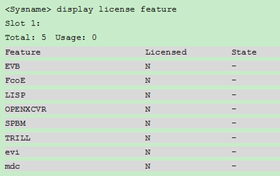
2. To use a license-based feature, purchase a software license certificate for it. The authorization serial number in the software license certificate is the license key.
Obtaining the DID file of the license server
1. Log in to the license server and open the activation file management page.
2. Click Export DID.
The DID file of the license server will be saved to the local disk.
Requesting an activation file on H3C License Management Platform
About this task
On H3C License Management Platform, you can use one of the following methods to request an activation file:
· Bind one license key to one license server in one request.
· Bind multiple license keys to one license server or multiple license servers in one request.
Adding license keys
1. Open a Web browser and access H3C License Management Platform at https://www.h3c.com/en/Support/Online_Help/License_Service/.
|
IMPORTANT: As a best practice, use Chrome 62 or above, IE 10 or above, or Firefox 60 or above. |
2. Access the License Activation Requests page as shown in Figure 48.
Figure 48 License Activation Requests page
3. Use one of the following methods to add license keys:
¡ To add license keys one by one:
# Enter or copy and paste a complete license key in the empty License Key box as shown in Figure 48, and then click Search & Add. The platform will automatically obtain the information associated with the license key.
# Repeat this step to add multiple license keys.
¡ To add license keys by uploading the QR code images for the license keys:
# Click the ![]() icon next to the License
Key box as shown in Figure 48, and
then upload the QR code image for a license key as shown in Figure 49.
icon next to the License
Key box as shown in Figure 48, and
then upload the QR code image for a license key as shown in Figure 49.
# Click Search & Add in Figure 48. The platform will automatically obtain the information associated with the QR code image.
# Repeat this step to add multiple license keys.
|
IMPORTANT: Make sure the uploaded image is complete and clear for the platform to correctly recognize it. |
Figure 49 Uploading the QR code image for a license key
¡ To add license keys in bulk.
# As shown in Figure 48, click Import & Add.
# In the dialog box that opens, you can use one of the following methods to import license keys in bulk to H3C License Management Platform:
- Click the Download Excel License Key Import Template link to download the Excel license key import template, as shown in Figure 50. The contents in the template are as shown in Figure 51. Enter license keys in the template, save the template, and then upload it to the platform. The license keys in the template are all imported to the platform.
- Click Select as shown in Figure 50 to upload a license key list file to the platform if an electronic license key list file is available. The license keys in the file are all imported to the platform.
Figure 51 Contents in the Excel license key import template
4. Select license keys to be activated, and then click Next, as shown in Figure 52.
Figure 52 Finishing adding license keys
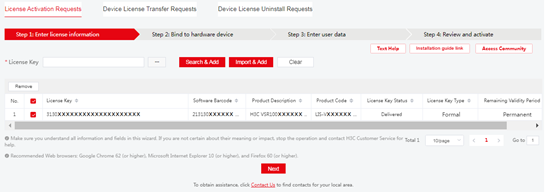
Binding license keys to license servers
1. Verify that the license keys to be activated are all added.
¡ To add a license key on the page as shown in Figure 53:
- Click Add.
- Enter or copy and paste a complete license key in the License Key column, or click the ![]() icon in the column to upload the QR code image for
a license key.
icon in the column to upload the QR code image for
a license key.
- Click the plus icon (+) to add the license key.
¡ To remove a license key, select that license key, and then click Remove.
Figure 53 Adding or removing license keys
2. (For feature licenses.) Enter license server information as instructed by H3C License Management Platform:
To obtain device information, use the method as described in "Obtaining the DID file of the license server."
Use one of the following methods to bind license keys to license servers:
¡ To bind one license key to one license server:
# Click the ![]() icon next
to the Custom
device
ID box in the license key entry, as shown in Figure 53.
icon next
to the Custom
device
ID box in the license key entry, as shown in Figure 53.
# In the dialog box that opens, set the device ID and upload the device info file of the license server as instructed, and then click Yes.
Figure 54 Entering device information

# Repeat the steps to bind multiple license keys to different license servers.
¡ To bind multiple license keys to the same license server:
# Select the license keys on the page as shown in Figure 53, and then click Bulk Bind.
# In the dialog box that opens, set the device ID, upload the device information file of the license server, and then click Yes.
|
IMPORTANT: · The custom device ID field is optional. The value for this field is user defined, and it is used to identify a license server. As a best practice to facilitate license server management and location, use the combination of the license server model, IP address, physical position, and other information as the custom device ID. This custom device ID takes effect only on the current license activation request. It cannot take effect after you leave the license activation request page and re-open the page. If you do not define a custom device ID, the license server automatically defines it. · The Import and Export buttons are not available for bulk binding. |
3. (For flexible feature licenses.) Enter license server information as instructed by H3C License Management Platform:
To obtain device information, use the method as described in "Obtaining the DID file of the license server."
To split one license key for use on multiple license servers:
# Click the ![]() icon next
to the Custom
device
ID box in the license key entry, as shown in Figure 53.
icon next
to the Custom
device
ID box in the license key entry, as shown in Figure 53.
# In the dialog box that opens, set the device ID, upload the device information file of the device, and enter the number of license units to be activated, and then click Yes.
Figure 55 Entering device information
# Configure the same parameters for a second license server, as shown in Figure 56.
# To enter device information for more license servers, click Continue to Add, and click Yes.
Figure 56 Enter device information for more license servers
|
IMPORTANT: The custom device ID field is optional. The value for this field is user defined, and it is used to identify a device. As a best practice to facilitate device management and location, use the combination of the device model, IP address, physical position, and other information as the custom device ID. This custom device ID takes effect only on the current license activation request. It cannot take effect after you leave the license activation request page and re-open the page. If you do not define a custom device ID, the device automatically defines it. |
4. Review the bindings carefully.
Each license key will be locked to the license server to which each of them is bound.
5. Make sure you understand the impact of the binding operation, and then select the option that explicitly states so, and then click Next, as shown in Figure 57.
Figure 57 Finishing binding license keys to license servers
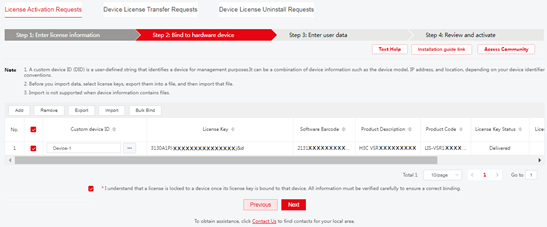
Specifying user information
As shown in Figure 58, enter user information, and then click Next. Table 4 describes the parameters.
If the entered email address is used for the first time on the platform, the platform displays the Email address validation page, as shown in Figure 59. Click Get verification code, and the platform will send a test mail to the specified email address. Enter the verification code in the test mail in the Verification Code field, and click Yes complete the verification.
Figure 58 Entering user information
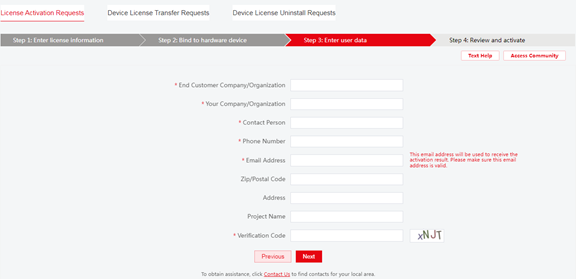
Table 4 User information configuration parameters
|
Parameter |
Remarks |
|
End Customer Company/Organization |
(Required.) Company or organization that uses the licenses. |
|
Your Company/Organization |
(Required.) Company or organization with which the license applicant works. |
|
Contact Person |
(Required.) Name of the contact person. |
|
Phone Number |
(Required.) Contact phone number. |
|
Email Address |
(Required.) Contact email address. H3C License Management Platform will send the generated activation files to this email address. Make sure the email address is correct and available. |
|
Zip/Postal Code |
(Optional.) Zip code or postal code for the contact address. |
|
Address |
(Optional.) Contact address. |
|
Project Name |
(Optional.) Project name. |
|
Verification Code |
(Required.) The verification code is case insensitive. |
Figure 59 Email address valiation page
Reviewing information and activating the licenses
1. Review the license key and device information, select I accept all terms and conditions of H3C License Service Portal Legal Statement, and then click Confirm & Activate, as shown in Figure 60.
Figure 60 Reviewing information and activating the licenses

2. Double-check the license and device information, and then click OK in the dialog box as shown in Figure 61.
Figure 61 Confirmation dialog box

The platform automatically generates an activation file for each binding and sends them to the specified email address.
3. Perform one of the following tasks to obtain activation files:
¡ If one license key is bound to one license server, the platform generates an activation file for the license server. To download the activation file, click Get Activation Info in the Get Activation Info column for the license key, as shown in Figure 65.
¡ If multiple license keys are bound to one license server, the platform generates a compressed activation file package for the license server. To download the compressed activation file package, click Get Activation Info in the Get Activation Info column shared by the license keys.
This document binds two license keys to one license server. The generated compressed activation file package contains two activation files, as shown in Figure 62.
Figure 62 License file information
¡ To obtain all activation files generated for this request, click Bulk Get Activation Info as shown in Figure 65. The activation files are as shown in Figure 63 and the activation information sheet is as shown in Figure 64.
|
IMPORTANT: As a best practice, click Bulk Get Activation Info to obtain all activation files generated for this request. The activation information sheet provided by this method facilitates you to record and manage activation files. |
Figure 63 License file information

Figure 64 Activation information sheet
![]()
¡ Access the email box at the specified address to obtain the activation files.
Figure 65 Downloading activation files
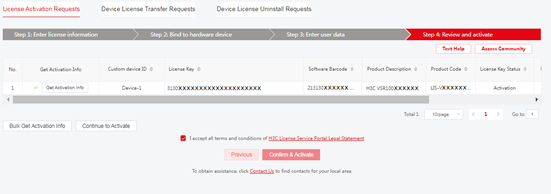
|
|
NOTE: · When you activate multiple license keys in bulk for a license server, H3C License Management Platform generates multiple activation files. After you install all generated activation files on the license server, you can use all of the licenses. · It takes some time for H3C License Management Platform to generate multiple activation files. In this scenario, you cannot download the activation files from the webpage. To obtain the activation files, you must access the email box at the specified address. · If you do not receive an activation file for a license key from the platform and you cannot use the license key to re-apply for license activation, contact H3C Support. |
Installing an activation file on the license server
|
CAUTION: Back up an activation file before you install it. If the activation file is inadvertently deleted or becomes unavailable for some other reason, you can use the backup activation file to restore the license. |
For more information about the procedures, see the documents for the license server.
Configuring a license client to obtain licenses from the license server
1. Log in to the CLI of the device.
2. Enter system view.
system-view
3. Specify the IP address and port number of the license server.
license server
4. Specify the username and password for the license client to connect to the license server.
license client
Make sure the specified username and password on the license client are the same as those configured on the license server.
5. Enable the license client.
license client enable
Viewing license information
# To view information about all licenses installed on the license server, access the Web interface of the license server. For more information about the procedures, see the documents for the license server.
# To view license statistics on a client, access the CLI of that client and execute the display license client statistics command in any view.
Figure 66 Sample output from the display license client statistics command

# To view information about licenses assigned to a client, access the CLI of that client and execute the display license client command in any view. This command displays license client configuration and license information on the license client.
Figure 67 Sample output from the display license client command
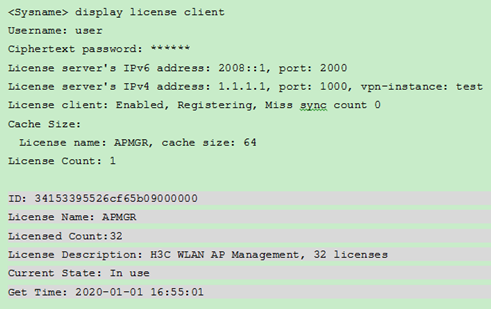
Transferring licenses
About this task
Perform this task to transfer a license that has not expired from one license server to another. You perform this task on the license server and H3C License Management Platform.
For the support of the product for license transfer, see its license compatibility information document.
License transfer workflow
To transfer licenses from one license server to another, use the workflow in Figure 68.
Figure 68 License transfer workflow
Restrictions and guidelines
You can transfer only formal licenses that have not expired.
Obtaining an Uninstall file for a license on the source license server
For how to obtain an Uninstall file for a license on the source license server, see the user guide for the license server.
Obtaining the host information file for the destination license server
For how to obtain the host information file for the destination license server, see "Obtaining the DID file of the license server."
Requesting license transfer on H3C License Management Platform
1. Log in to H3C License Management Platform at http://www.h3c.com/en/License.
|
IMPORTANT: As a best practice, use Google Chrome 62 (or higher), Microsoft Internet Explorer 10 (or higher), Mozilla Firefox 60 (or higher). |
2. Click the Device License Transfer Requests tab.
If you have not logged in to the system, the Log In page opens. Enter your account information and log in to the system as instructed. This prevents unauthorized license transfer, protects asset security, and ensures traceability of the transfer operations.
Upon a successful login, you are redirected to the Device License Transfer Requests page.
|
|
NOTE: Finish license transfer within 4 hours after you access the license transfer request page. If you fail to do that, the system will request you to log in again and automatically return to the first application step. |
Figure 69 Accessing the Device License Transfer Requests page
3. Select Uninstall File, and then click Click to Upload to upload the Uninstall file created on the source license server.
Click Search & Add to obtain uninstallation information. Repeat this step to upload all uninstallation information.
Figure 70 Uploading an Uninstall file
The license server does not support Uninstall keys.
To transfer multiple licenses, click Click to Upload to upload multiple Uninstall files in bulk.
4. Select the uninstallation entries to be uninstalled, and then click Next.
5. Bind uninstalled entries to the destination license server, and then click Next. For more information, see "Binding license keys to license servers."
6. Enter user information, and then click Next. For more information, see "Specifying user information."
7. Review the information and activate the license to obtain a new activation file for the destination device. For more information, see "Reviewing information and activating the licenses."
Installing an activation file on the destination license server
|
CAUTION: Before you install an activation file, back up the file and keep the backup activation file in a safe place. If the activation file is deleted or the license becomes unavailable because of device failure, you can use the backup activation file to restore the license. |
For how to install an activation file on the destination license server, see "Installing an activation file on the license server."
Uninstalling a license
About this task
A license is bound to a license server once you obtain an activation file based on the license key and hardware information of the license server on H3C License Management Platform. You can bind a license only to one license server.
To transfer or restore the license before it expires, you must first uninstall its activation file from the license server, and then request license uninstallation on H3C License Management Platform.
After license uninstallation is approved, the license key is available for use again. You can use it to obtain a new activation file on H3C License Management Platform to transfer the license to another license server or restore the license on the original license server.
For the support of the product for license uninstallation, see its license compatibility information document.
License uninstallation workflow
Figure 71 Uninstallation workflow
Restrictions and guidelines
You can uninstall only formal licenses that have not expired.
Obtaining an Uninstall file for a license
1. Log in to the license server.
2. Select the activation file for a license, click Uninstall in the Actions column for that file, and then click Export Uninstall File.
Requesting license uninstallation on H3C License Management Platform
|
CAUTION: If you cannot obtain an Uninstall file because of license server failure, contact H3C Support to unbind the device from the license. |
To request license uninstallation on H3C License Management Platform:
1. Log in to H3C License Management Platform at http://www.h3c.com/en/License.
2. Click the Device License Uninstall Requests tab.
If you have not logged in to the system, the Log In page opens. Enter your account information and log in to the system as instructed. This prevents unauthorized license uninstallation, protects asset security, and ensures traceability of the uninstallation operations.
Upon a successful login, you are redirected to the Device License Uninstall Requests page.
|
|
NOTE: Finish license uninstallation within 4 hours after you access the license uninstall request page. If you fail to do that, the system will request you to log in again and automatically return to the first application step. |
Figure 72 Device License Uninstall Requests page
3. Select Uninstall File, click Click to Upload to upload the Uninstall file created on the source license server, and then click Search & Add. Select entries to uninstall, and then click Next.
To upload multiple Uninstall files in bulk, click Click to Upload.
4. Enter user information, and then click Next. For more information, see "Specifying user information."
5. Review the uninstallation information, and then select the option that explicitly states your acceptance of all terms in the legal statement.
6. Click Confirm & Uninstall.
7. Review license and device information, and then click OK. The binding between the device and license key will be removed.
Appendix A FAQ
License activation
Q: What is a license key and what is an activation key or activation file?
A: A license key uniquely identifies a license. An activation key or activation file uniquely binds a license key to a device. To use a license-based feature on a device, you must install the activation key or activation file for that license on the device.
· To obtain a license key, purchase a software license certificate from an H3C approved sales channel.
· To obtain an activation key or activation file, access H3C License Management Platform at https://www.h3c.com/en/Support/Online_Help/License_Service/. Then, request an activation key or activation file based on the license key and hardware information of the target device.
Q: Can I install the license for a feature only on one member device in an IRF fabric?
A: No. Licenses are device locked. To make sure a license-based feature can take effect after a master/standby switchover, install a license of the same specification on each of the member devices for that feature.
Q: Can I modify the system time of the device after a license is installed?
A: It depends on the license validity period.
· For a permanent license or a days-restricted license, modifying the system time does not affect the license validity period.
· For a date-restricted license, system time modification might shorten the license validity period. As a best practice, do not modify the system time after the activation file is installed.
Q: Might the DID file for the device change? What impact does a DID file change have?
A: The DID file would change if you compress the license storage area by using the license compress command.
The DID file change does not affect the activated licenses on the device. However, you will be unable to install the activation keys or activation files obtained by using the old DID on the device. To resolve the issue, contact H3C Support.
To obtain a new activation file, you must export the new DID file from the device.
Q: Will activated license activation files be lost after the device reboots or the device software upgrades?
A: No, they will not.
Q: How do I deal with an invalid license after a hardware change?
A: A license on the license server will become invalid after a hardware change (for example, CPU or NIC replacement). To restore the license, use one of the following methods:
· License transfer—Perform the following steps:
a. Uninstall the license and export the Uninstall file. For license servers in E11XX versions, you can only use bulk uninstallation to uninstall licenses.
b. Obtain a new DID file for the license server.
c. On H3C License Management Platform, use the Uninstall file and new device information to request license transfer and obtain a new activation file.
d. Install the new activation file on the license server.
· License uninstallation and reactivation—Perform the following steps:
e. Uninstall the license and export the Uninstall file. For license servers in E11XX versions, you can only use bulk uninstallation to uninstall licenses.
f. Obtain a new DID file for the license server.
g. On H3C License Management Platform, use the Uninstall file to request license uninstallation, which unbinds the device and the license key.
h. Use the license key and new device information to request a new activation file.
i. Install the new activation file on the license server.
Support for license transfer or uninstallation depends on the product model. For more information, see the license matrixes document for that product.
License uninstallation
Q: Can I uninstall an expired license?
A: No, you cannot. To delete expired licenses, execute the license compress command.
Q: How do I obtain the Uninstall key for a license?
A: Execute the display license command, identify the activation key for the feature license, and examine the Uninstall Key field for its Uninstall key. The value for this field depends on the device model.
Figure 73 Sample output from the display license command
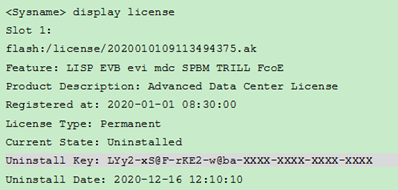
Q: Can I install an uninstalled activation file on the device again?
A: No. An activation file will become invalid after you uninstall it. To restore the license, use one of the following methods:
· License transfer—On H3C License Management Platform, use the Uninstall key or Uninstall file to transfer the license to the device again and obtain a new activation file. Then, install the new activation file on the device.
· License uninstallation and reactivation—Perform the following operations:
a. On H3C License Management Platform, use the Uninstall key or Uninstall file to request license uninstallation, which unbinds the device and the license key.
b. Use the license key and device information to request a new activation file.
c. Install the new activation file on the device.
Support for license transfer and uninstallation depends on the device model. For more information, see the license matrixes document for that product..
Q: How do I delete expired and uninstalled licenses?
A: Execute the license compress command. This operation will change the DID or DID file.
As a best practice, perform the following tasks before you compress the license storage:
· Back up the Uninstall keys or Uninstall files of uninstalled licenses for subsequent license transfer or license uninstallation.
· Install all idle activation keys or activation files registered with the old DID.
Q: What should I do if I inadvertently delete the activation file for a license?
A: After you delete the activation file for a license, you will be unable to use the licensed feature or uninstall its license for file transfer.
To resolve the issue:
1. Execute the copy command to copy the backup activation file to the license folder in the root directory of the storage medium on the device, for example, flash:/license.
2. Reboot the device. Then, the licensed-feature continues to take effect and you can uninstall the license if needed.
License retrieval
Q: How do I retrieve a lost license key?
A: If you lose the license key before obtaining an activation key or activation file, contact H3C Support to retrieve the license key based on the license purchase contract.
If you lose the license key after obtaining an activation key or activation file, contact H3C Support and provide the activation key or file or the device information.
Q: How do I retrieve an activation key or activation file?
A: You will be unable to use a licensed feature if its activation key or activation file is lost or inadvertently deleted. To retrieve an activation key or activation file, use one of the following methods:
· Use the backup activation key or activation file.
· Find the activation key or activation file from the email box of the applicant.
· Contact H3C Support and provide the license key or device information to retrieve the activation key or activation file.
Q: How do I transfer licenses when a node fails or when license transfer is required?
A: Contact H3C Support for help.
Q: What should I do if the activation files for licenses are lost after the factory defaults are restored?
A: Contact H3C Support for help.


